2025/03/21Number of reading(16430)Number of comments(0)
一、Target Audience
Operators, Management
二、Feature Introduction
When operating products on Amazon, you need to track and analyze changes in a lot of data daily, such as: sales, advertising, orders, profits, inventory, performance, customer service, etc., in order to optimize in a timely manner, ensure normal product sales, and promote positive overall business development. Therefore, with such a huge amount of data information, if you don't focus on the key points and try to look at everything, you will end up being inefficient and ineffective.
To address this issue, we have launched the [Homepage Dashboard] feature, which extracts the core metrics of daily operations. On a single page, you can easily access all the data you want to analyze and grasp the overall business situation of your store.
The SellerSpace Homepage Dashboard is a comprehensive data analysis panel that can track daily real-time business data and also supports analyzing core store business data for all marketplaces and time periods, including indicators such as: sales, orders, advertising, profit, expenses, etc., making sales profit and loss clear at a glance.
In addition to sales data, it also displays basic data such as store performance, customer service, and inventory issues, helping sellers to know about negative reviews and restock alerts as soon as possible, making it convenient for timely handling.
三、Use Cases
- Track and analyze real-time daily business data for your store
- Analyze core store business performance across all marketplaces and time periods
- Quickly identify ASINs suitable for promotion through order product distribution information
- Timely detect product hijacking, negative review performance, and FBA restock alerts
- Customize the default homepage dashboard and choose other features as the homepage
四、Operation Guide
The SellerSpace Homepage Dashboard is a comprehensive data analysis panel that can help track and analyze daily real-time business data, and also analyze core store business performance across all marketplaces and time periods.
It includes 8 dashboards: Real-time Sales, Order Analysis, Advertising Performance, Profit & Expenses, Top 10 Ads, Store Performance, Customer Service and FBA Inventory.
 +
+
The homepage dashboard defaults to displaying today's sales data for all marketplaces. We can also customize to view and analyze business data for different times and different marketplaces.
At the same time, you can also customize the layout of the data panels and adjust them to your preferred mode.
Select Time
Click the preset time period in the upper right corner of the page to directly switch the preset time period. Or customize to select the corresponding time period.
Note: If you are viewing multiple marketplaces, the data displayed is the data for the corresponding marketplace time zone.
 +
+
Select Marketplace
Click the [Marketplace Selection] button in the upper right corner to select to view homepage dashboard data by [Marketplace], [Country], or [Store]. Multiple selections are supported.
 +
+
When summarizing performance for multiple stores, choose to display it in the same currency for easy comparison. The exchange rate is based on the People's Bank of China on the same day, and this [Summary Currency] setting applies to all multi-marketplace summary data in the system.
Click [Currency] to enter currency selection.
 +
+
Select a unified currency:
 +
+
Customize Layout
The panels of each section of the homepage dashboard support customized layout. You can set each section to your desired layout format.
Click [Customize Page] in the upper right corner to enter the settings page.
 +
+
We can drag each section to the desired position and click [Save].
 +
+
In addition to customizing the layout of the homepage dashboard, considering that different sellers have different operating habits, we also support setting different feature pages as the SellerSpace homepage.
Click the personal avatar in the upper right corner and select [Profile Center].
 +
+
Enter the personal center,
Find "Default Backend Homepage" and select the corresponding feature as the homepage.
After setting, the next time you log in, the set feature will be the backend homepage.
 +
+
Next, we will explain the data principles and operation methods of each section in turn.
Section 1: Sales Dashboard
The Real-time Sales section displays three data points for the selected marketplace and date: Order Quantity, Units Sold, and Sales Revenue. It includes 2 types: Amazon Backend - Sales Dashboard and SellerSpace - Order Synchronization Summary & Budget.
What are the differences between the two?
The data sources are different.
Amazon Backend - Sales Dashboard: Data comes from Amazon Backend -> Business Reports -> Sales Dashboard. In SellerSpace, it is only used for display and indicates consistency with the Amazon backend display, and is not involved in profit calculation.
SellerSpace - Order Synchronization Summary & Budget: Data comes from Amazon Backend -> Manage Orders. Order incremental synchronization summary and budgeted sales revenue are obtained. In the SellerSpace system, it is one of the data for calculating profit.
Click here to learn "Why are there 2 sales revenues?"
 +
+
The Real-time Sales section will also display period-over-period data comparison for easy analysis of data changes.
For example: If we choose to view "Today", it will display the period-over-period data from "Yesterday". If you choose "Last 7 Days", the period-over-period will be the "Previous 7 Days". If it is "Last Month", the period-over-period will be the "Month Before Last", and so on.
 +
+
Hover your mouse over the Order Quantity, Units Sold, or Sales Revenue section to view the specific increase or decrease of period-over-period data.
 +
+
If the date selected is data for the last three days, we can also refresh the data time.
Why is refresh supported?
Due to some Pending orders, Amazon may revise its data. The Amazon backend will be updated synchronously and returned through the API. Therefore, we can manually refresh the data to obtain the latest data. Amazon can basically complete the update within 3 days.
Click the [Refresh] button to refresh with one click.
 +
+
The method for viewing the metric definitions of the homepage dashboard is slightly different from other features.
You need to hover your mouse over the metric title to view the corresponding detailed definition. (For other features, hover over the small question mark icon)
 +
+
Section 2: Order Analysis
The Order Analysis section includes data in 3 dimensions: Order Marketplace Distribution, Order Product Distribution, and Order 24-Hour Distribution. On one page, we can complete order analysis by marketplace dimension and product dimension, and also view and analyze the hourly order distribution in 24 hours.
Through order analysis, we can deeply understand the sales situation of marketplaces, find out which new products are suitable for advertising promotion, the peak order time period of products, concentrated order areas, etc., to help us discover more business opportunities and more easily promote best-selling products.
Note: Order area distribution was historically a beta version, and now it has been fully developed and added to the [Product Analysis] and [Marketplace Analysis] features to help sellers understand the order situation in different regions and analyze the reasons for returns and exchanges.
 +
+
2.1 Order Marketplace Distribution
Starting from the marketplace dimension, it displays the core sales situation of the selected marketplace stores and the selected time period. Core metrics include: Units Sold, Order Quantity, Sales Revenue, Total Expenses, Advertising Orders, Advertising Units Sold, and Advertising Sales Revenue.
Through order marketplace distribution, we can clearly understand the profit and loss situation and advertising performance of each marketplace at a glance.
 +
+
In SellerSpace, all underlined values can be hovered over to view details, or clicked to jump to view details.
For example:
Click the order quantity/units sold number to jump to view order details.
 +
+
Hover your mouse over the total expense amount to view expense details, including: Expense Type, Expense Amount, Proportion of Different Types to Total Expenses, Proportion to Sales Revenue, and Proportion to Profit.
By analyzing the proportion of expenses, it can help us clarify which expenses are over budget and need to be optimized; which expenses can be increased to help increase sales, etc.
 +
+
Click Advertising Orders to view which advertising campaigns advertising orders are distributed in, helping us confirm whether the advertising order distribution is reasonable, which campaigns need to be optimized again, etc.
 +
+
Click Advertising Spend to view which advertising types the marketplace's advertising spend is distributed in, helping us allocate advertising budgets more reasonably. Among them, clicking the [View Details] button after each advertising type can also further jump to view the performance details of that advertising type.
 +
+
Order marketplace distribution, the system defaults to sorting in descending order by [Order Quantity]. It also supports selecting to sort in descending order by other metrics to help us view the performance of the marketplace under the corresponding metric.
 +
+
Marketplace Analysis
If you want to further analyze the data of a single marketplace in detail, we can click the analysis button on the right side of the marketplace name to analyze the business data of that marketplace separately.
 +
+
Enter the marketplace analysis page,
Marketplace analysis starts from 5 dimensions, including: Historical Performance of Various Metrics, Order 24-Hour Distribution, Expense Details, Period-over-Period Comparison of Metrics, and Advertising Performance, helping us deeply understand the business situation of the marketplace, timely discover abnormal performance, and identify gaps and deficiencies.
 +
+
① Historical Performance of Various Metrics
The marketplace dimension has a total of 40 metrics that can be analyzed, helping us deeply analyze the performance of each metric, find out abnormal situations from different metrics, or help us track whether the effect of optimization operations meets the standards, so that we can optimize promotion methods in time according to business goals.
The operation method of historical performance data of metrics is as follows:
Taking the analysis of the advertising ACOS performance of SellerSpace K - US marketplace last week as an example,
First, set the data time.
Click the time and select the data time as [Last Week].
 +
+
Supplementary explanation:
The display form of data will be slightly different depending on the time range selected.
If you select a single day, the metric data will be displayed in the "hour" dimension. And when we select [Today] or [Yesterday], only the metrics: Sales Revenue, Units Sold, and Order Quantity are displayed;
If you select multiple days and within a week, you can choose to display metric data in the "hour" or "day" dimension;
If you select more than a week, you can choose to display metric data in the "day" or "week" dimension.
You can choose the corresponding data time range according to the actual situation you want to analyze.
Select a single day to display data in the "hour" dimension:
 +
+
Select multiple days and within a week to display data in "hour" or "day":
 +
+
Select more than a week to display data in "day" or "week":
 +
+
Then, select the analysis marketplace.
We can choose to analyze the historical performance of various metrics for different marketplaces.
Click the [Marketplace Selection] button in the upper left corner to switch the marketplace to [SellerSpace K - US Marketplace] with one click.
 +
+
Next, select the data display format.
There are 2 display formats for metrics: Graph + Table. According to the data display format, we can set the metric display order or quantity separately.
Click the icon in the upper right corner to switch the display format with one click.
The current display format is table, so no switching is needed.
 +
+
Finally, we can choose to set the metric display order.
When [Table] format is selected, we can customize the display order of metrics.
We want to analyze the [ACOS] metric, but it cannot be analyzed alone, and needs to be analyzed together with other advertising metrics. Therefore, we can choose to put the required advertising metrics together for easy viewing.
Click [Set Metric Display Order] in the upper right corner to enter the settings.
 +
+
Customize the metric display order, drag and drop to sort, and put advertising-related metrics together for easy analysis.
 +
+
Note: The above operation order is not a fixed order, just operate according to your needs.
At this time, we can analyze the advertising ACOS of last week.
 +
+
For example:
From the data in the figure, it can be seen that the overall ACOS of this marketplace last week was relatively high.
At this time, we need to analyze the reasons for the high ACOS: Is it caused by promoting new products leading to high ACOS, because the advertising goal of new products is to obtain high exposure and high traffic, and the conversion is low, is this the reason for pulling up the overall ACOS? Or is it because the keywords are not accurate, resulting in some irrelevant matching keywords, consuming a lot of budget, and without conversion, resulting in high ACOS? ... You can analyze specifically according to the actual situation.
In addition to the above [Table] data display format, we can also choose the [Graph] format to analyze the historical performance of metrics.
Graphs can more intuitively view the historical performance trend of metrics, whether it is an upward or downward trend, or other performance, etc.
The following explains the operation method of the graph:
Click the switch button in the upper right corner to switch to the graph with one click.
 +
+
We can set the default display metrics and metric display order for [Graph].
Click the [Set Default Display Metrics] button to enter the settings.
 +
+
Set default display metrics:
 +
+
Special reminder: When the data time is selected as [Today] or [Yesterday], the 24-hour trend data of Units Sold, Order Quantity, and Sales Revenue will be displayed by default, not based on the set display metrics.
Graph operation tips tutorial:
Hover your mouse over the curve to view detailed data of the corresponding node;
 +
+
Hover your mouse over a single curve to view which metric the curve corresponds to, and the detailed data of the corresponding node;
 +
+
Click the curve to only view the metric corresponding to the curve. Move the mouse out of the curve and click again in the blank space to restore to displaying all the default metrics you set;
 +
+
Click the metric below the [Set Default Display Metrics] button to hide or add display metrics;
 +
+
In addition to the curve trend chart, the column graph view is also supported, and its operation method is consistent with the curve trend chart.
Click the graph button on the right to switch with one click.
 +
+
Data export:
After we finish the analysis, we can export the current analysis data results. The export format is Excel spreadsheet, which is convenient for us to re-organize and analyze.
Click the [Export] button to export with one click.
 +
+
② Order 24-Hour Distribution
The order 24-hour distribution of marketplace analysis is mainly to view the 24-hour distribution of order quantity, units sold, and sales revenue of the selected marketplace.
It is similar to [Hourly Sales Data for the Last Four Weeks], but also slightly different. The specific differences are as follows:
Hourly Sales Data for the Last Four Weeks: Only data for the last 28 days can be viewed, but it supports viewing the 24-hour order distribution of different products, marketplaces, advertising, and tagged products;
Order 24-Hour Distribution: Supports viewing data for the entire time period, but only supports viewing the 24-hour order distribution of marketplace or product dimensions.
 +
+
The data operation method of order 24-hour distribution is as follows:
Taking the graph format to view the order 24-hour distribution of last month as an example.
Same as the operation of [Historical Performance of Various Metrics], we can customize the data time range.
Click the time icon in the upper left corner to set the time range and select [Last Month].
 +
+
Then select the display format: Graph.
Order 24-hour distribution has two display formats: graph and table.
The current format is table. Click the icon in the upper right corner to switch to [Graph] format with one click.
 +
+
The order 24-hour distribution graph defaults to displaying the 24-hour distribution of 3 metrics: Order Quantity, Units Sold, and Sales Revenue.
Click the metric title to switch to view the hourly distribution of the corresponding metric.
The system defaults to viewing order quantity data, so we don't need to switch.
 +
+
Through the above operations, the 24-hour order distribution data for last month is displayed.
Next is the explanation of analysis operations.
Order 24-hour distribution will also synchronously display period-over-period data comparison for easy analysis of data changes.
For example: If we choose to view "Today", it will display the period-over-period data from "Yesterday". If you choose "Last 7 Days", the period-over-period will be the "Previous 7 Days". If it is "Last Month", the period-over-period will be the "Month Before Last", and so on.
 +
+
Click the period-over-period metric icon to choose to view or hide the trend data of the metric separately.
 +
+
Hover your mouse over the period-over-period metric, or the corresponding data in the graph, to view the trend of the data separately.
 +
+
Hover your mouse over the graph in the chart to also view the details of the data separately.
 +
+
When we choose the [Graph] display format,
In addition to the column graph, you can also switch to curve graph, stacked column chart, or copyable table graph to adapt to sellers with different analysis habits.
Click the icon on the right to switch with one click.
Note: The operation methods of [Graph] charts are basically consistent with the graph operation tips of [Historical Performance of Various Metrics], and will not be explained here again.
 +
+
Curve chart:
 +
+
Column chart:
 +
+
Stacked column chart:
 +
+
Copyable table:
 +
+
When it is in graph display format, the graph supports export, and the export format is image format, which is convenient for us to make reports.
Click the export button to export with one click.
 +
+
When we choose the [Table] display format,
It displays the 24-hour data of order quantity, units sold, and sales revenue, as well as their period-over-period comparison data.
Note: The table data here does not support export!
 +
+
③ Order Area Distribution (Newly Launched)
Order area distribution displays the distribution of order areas for the current marketplace, as well as the area distribution data of refund and exchange orders. Through order area distribution data, we can understand which areas orders come from.
If the marketplace sells similar products, it is also equivalent to summarizing and analyzing the main order areas of this type of product, and then combining with the [Keyword Ranking] and [Keyword Rank Positioning] features to help us promote keywords more accurately and obtain more precise orders.
At the same time, we can also efficiently analyze return and exchange areas and reasons, helping us obtain first-hand buyer feedback, and then optimize products and improve profit margins.
 +
+
Taking the analysis of the order and return/exchange area distribution of SellerSpace K - US marketplace last month as an example.
First, select the data time: Last Month.
We can customize the data time range. However, it is recommended to choose a time period with a larger span for analysis.
Due to some pending orders, Amazon may return data as 0 within a certain period of time, including order address data. At this time, the number of orders with unknown order areas is large, which is not convenient for analysis.
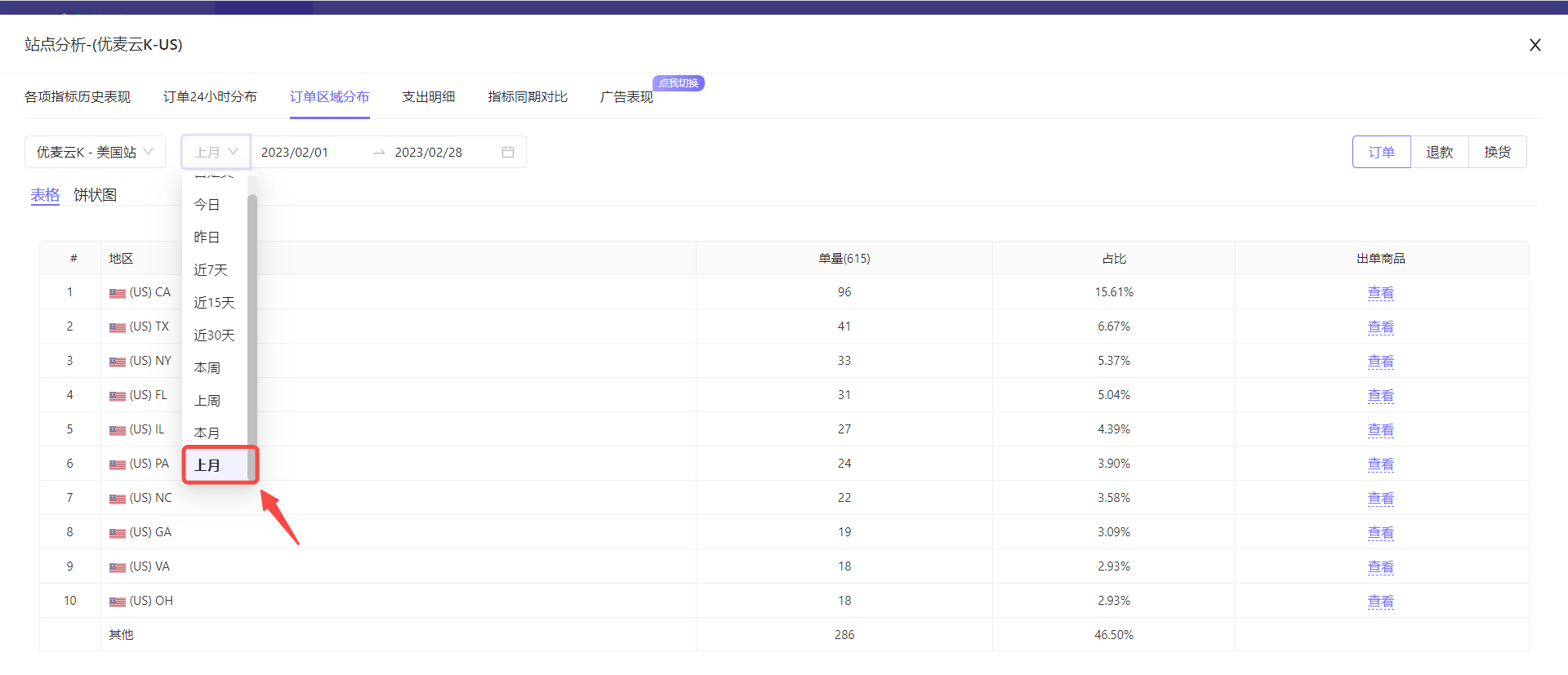 +
+
Then, select the marketplace: SellerSpace K - US Marketplace.
Click the marketplace selection button in the upper right corner to select with one click.
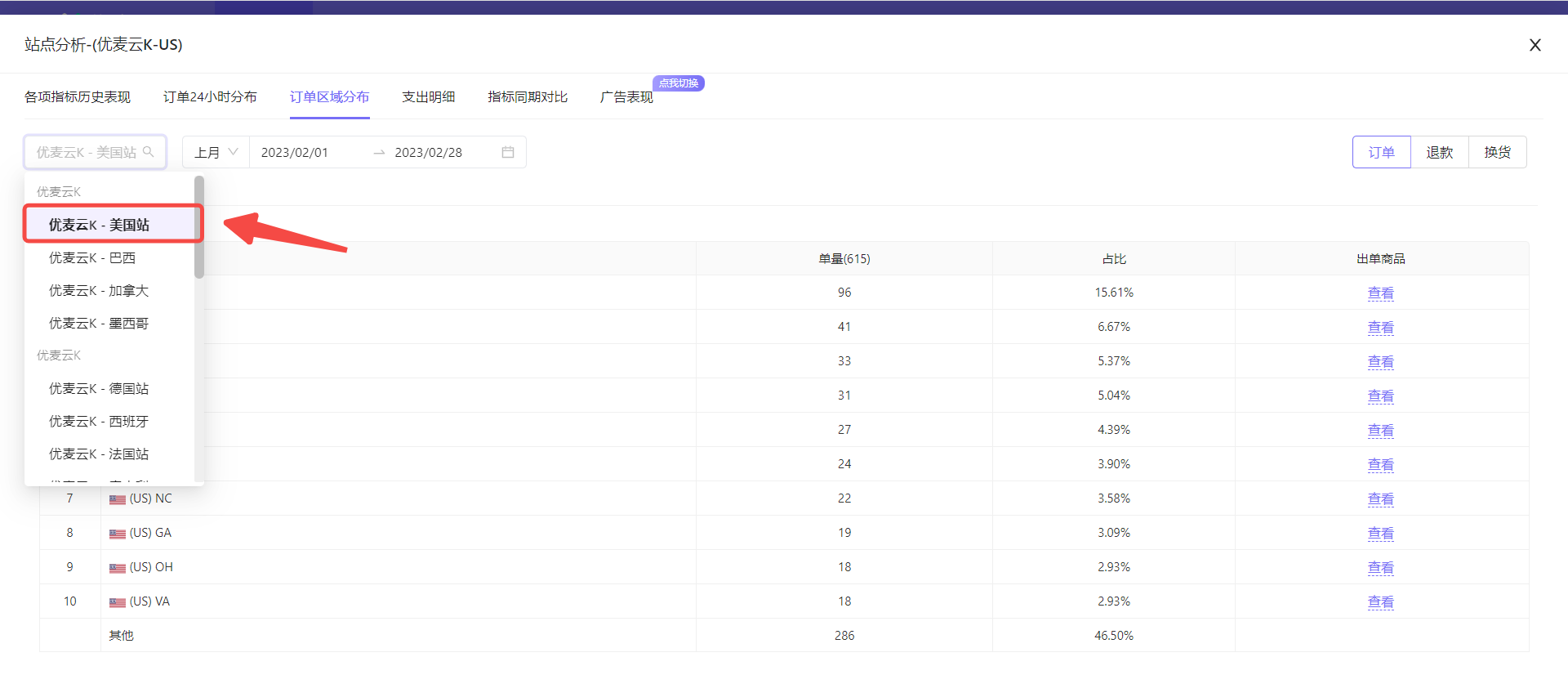 +
+
After selection, the system will automatically display the top ten order areas in terms of order quantity in the orders of the marketplace last month in table format.
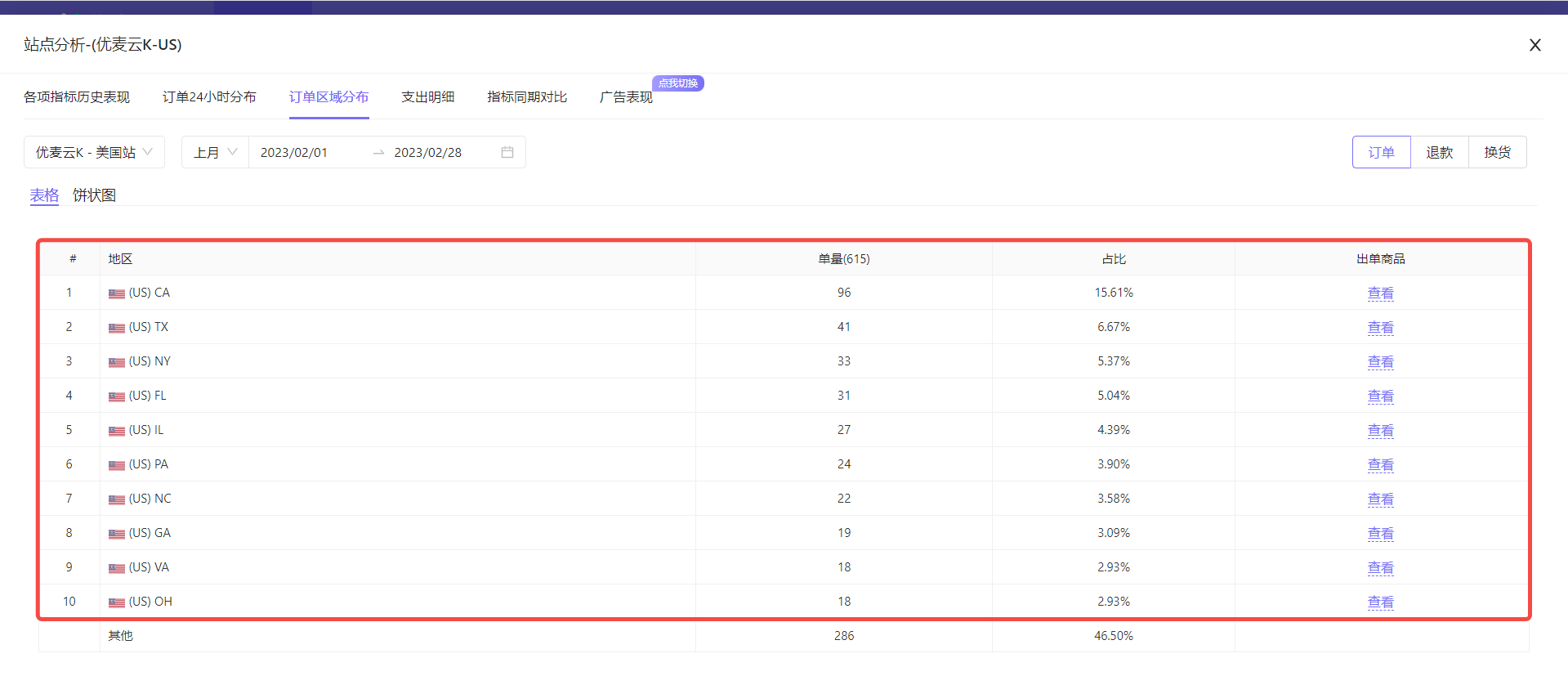 +
+
Among them, in addition to the clear areas, it may also include two data points: Unknown and Other:
- Unknown: Orders for which the address was not obtained, such as pending orders, often appearing in recent time periods
- Other: Addresses with order quantities outside the top ten are collectively classified as "Other"
Data for the last 15 days:
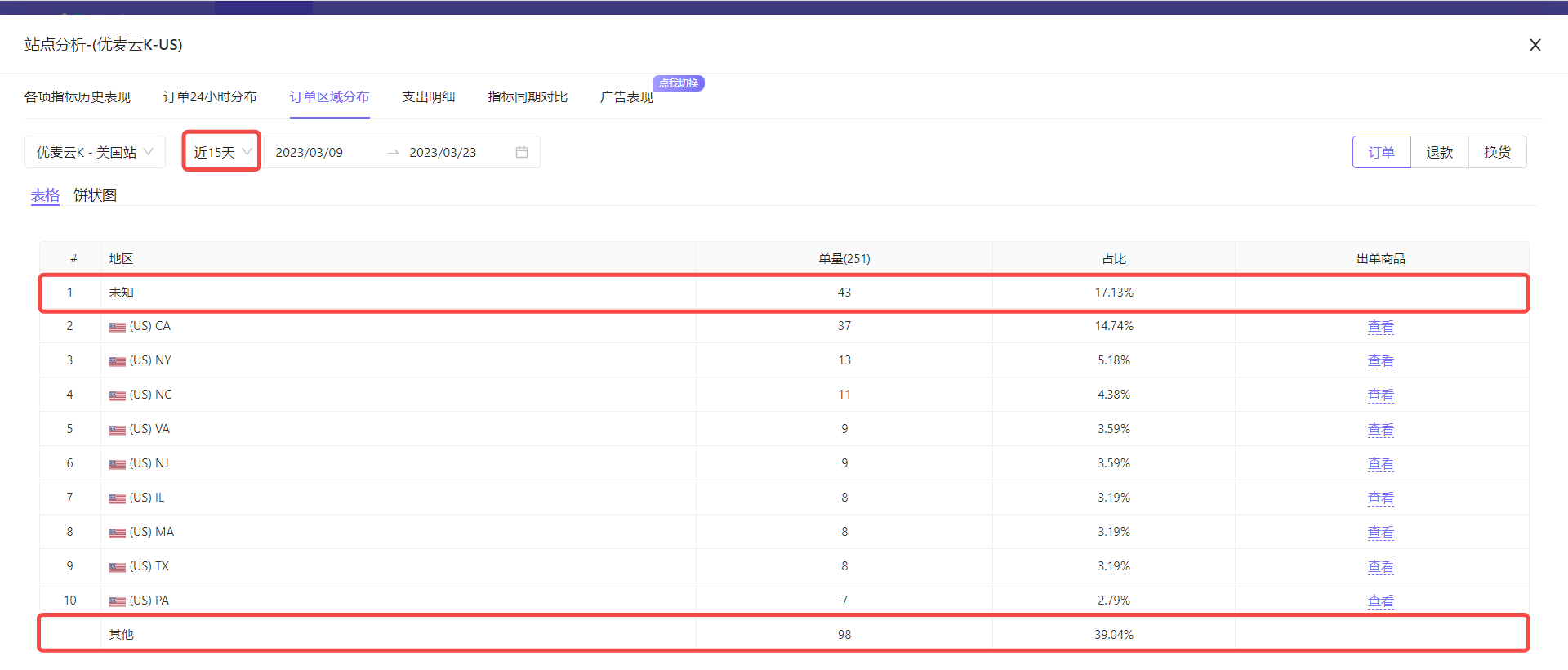 +
+
Data for last month:
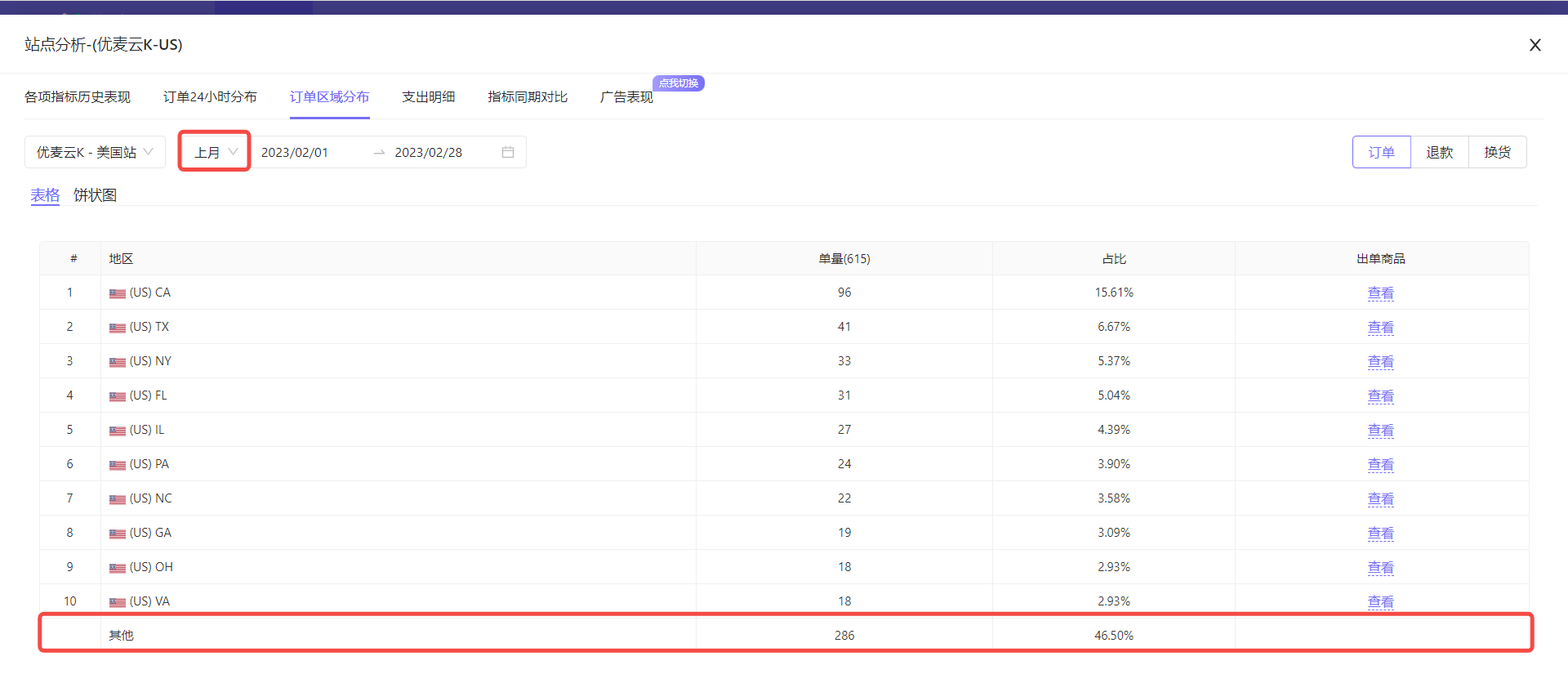 +
+
In addition to the table format, we can also view the top ten area information in pie chart format.
Click the [Pie Chart] button to switch with one click.
 +
+
Hover your mouse over the corresponding pie slice to also view detailed data.
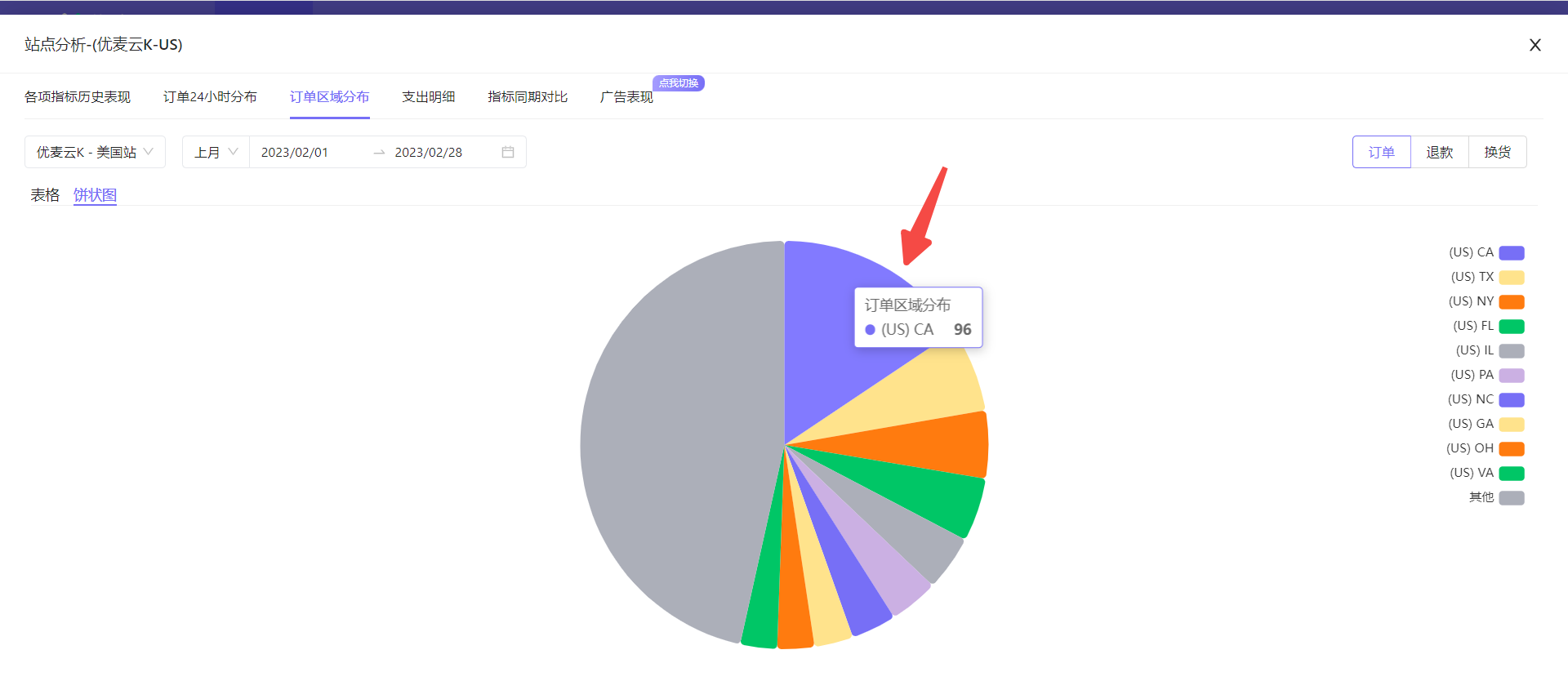 +
+
Click the slice on the right to display or hide the data separately.
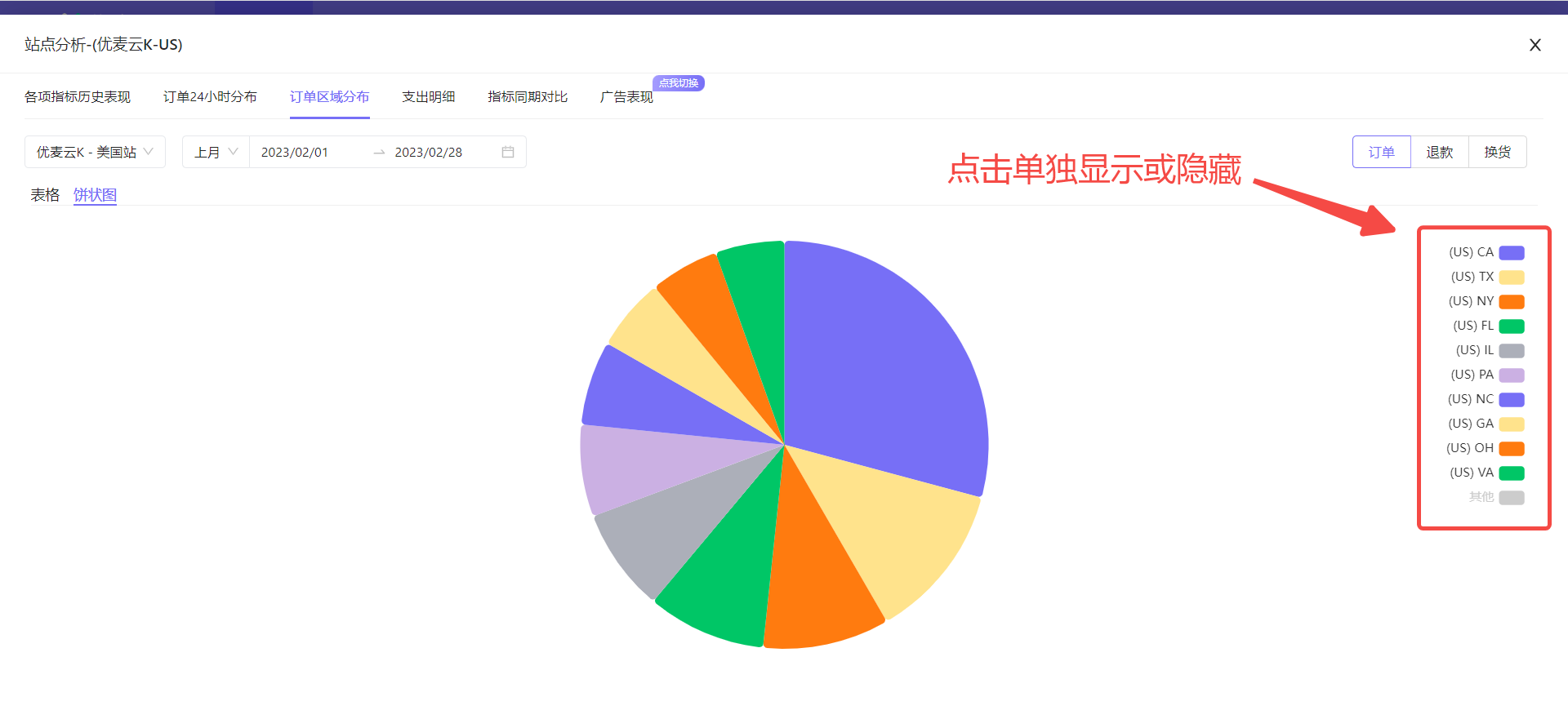 +
+
In addition to viewing the order distribution of all orders, you can also view the products sold in the top ten order areas, and analyze the area distribution and reasons for returns and exchanges.
View the products sold in the top ten order areas:
Return to the table data mode, and click the [View] button on the right side of the corresponding area to view.
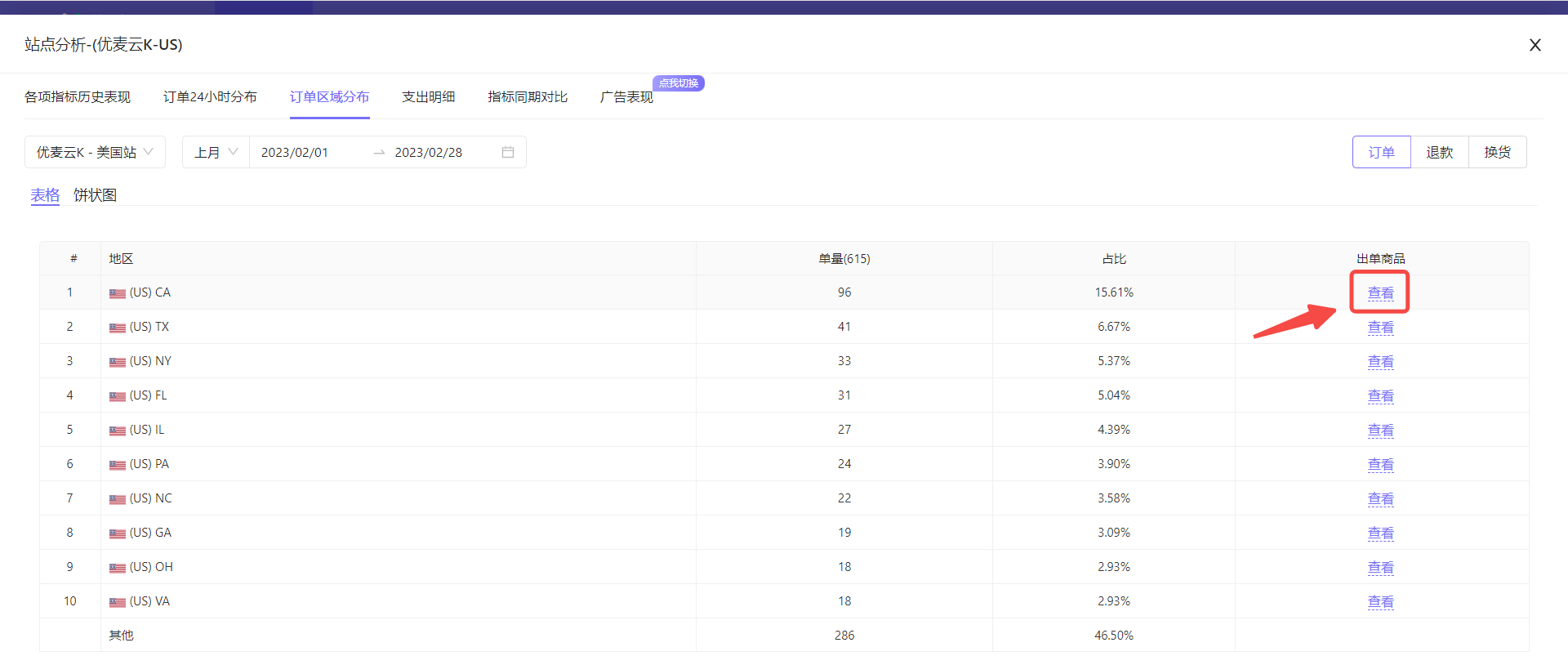 +
+
Products sold in the area:
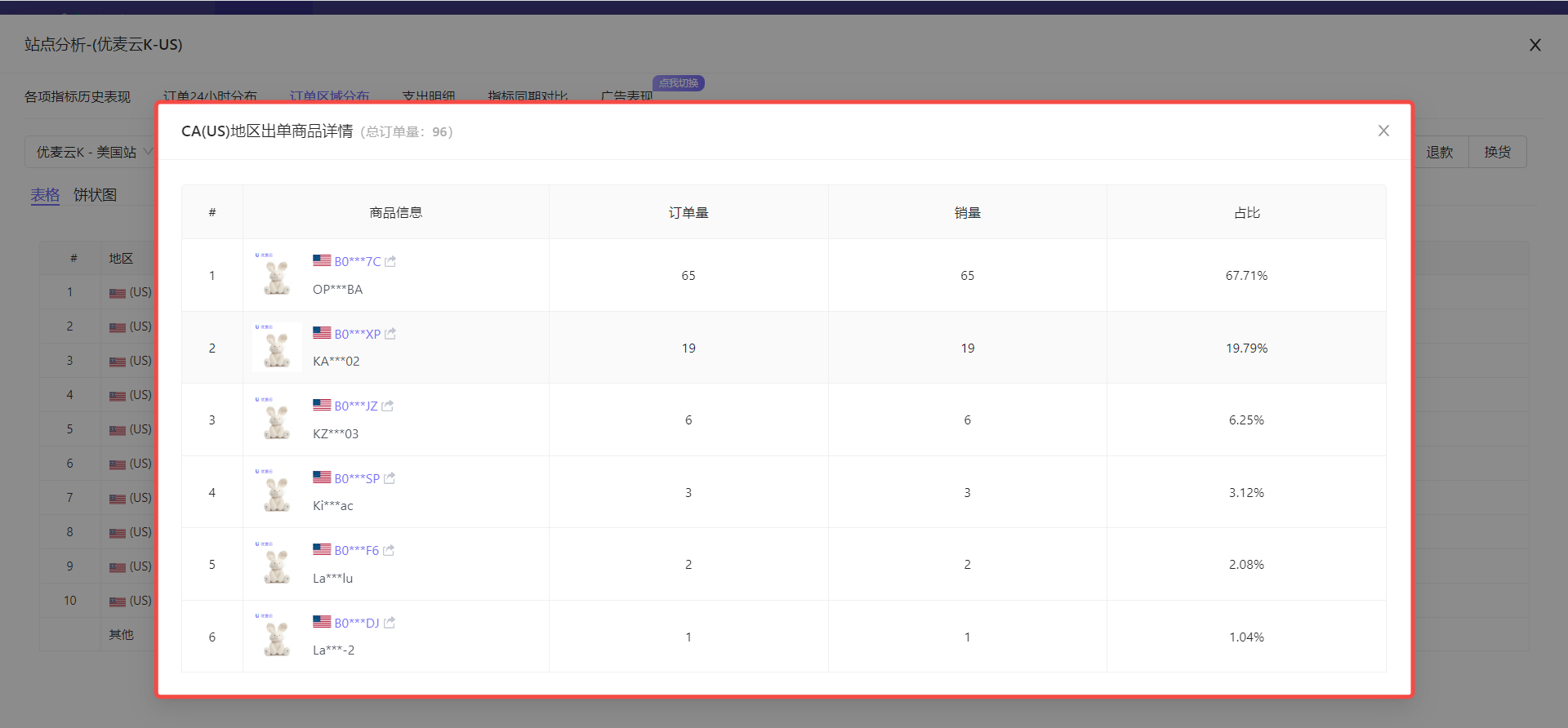 +
+
Return and Exchange Area and Reason Analysis Operation Method:
The viewing and analysis operation of return and exchange area distribution is consistent with that of order area distribution.
Click the data button in the upper right corner to switch with one click.
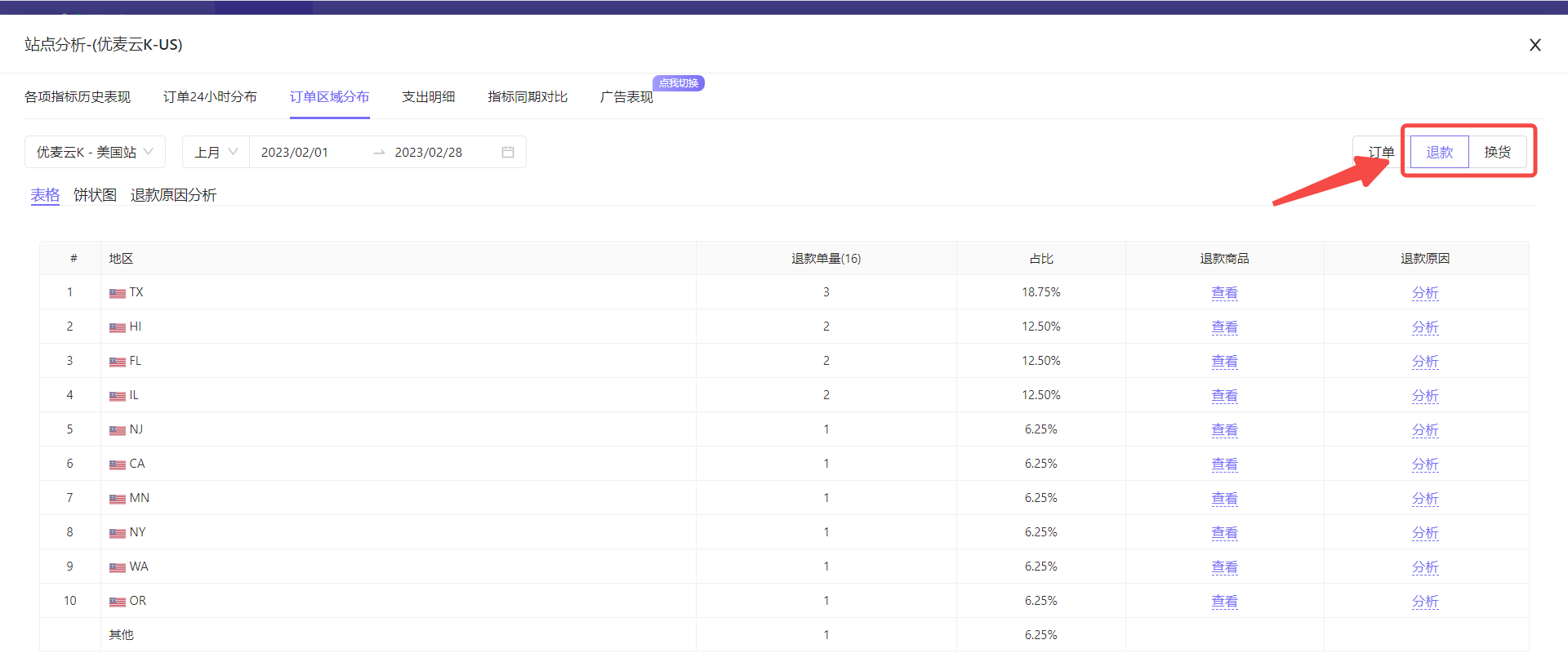 +
+
In addition to area distribution analysis, we can also directly analyze refund and exchange reasons here, and the method is consistent.
Special note: If the products sold in the selected marketplace are of many different types, then the refund and exchange reason analysis in the marketplace dimension is not very meaningful. It is recommended to go to the [Product Analysis] feature and analyze the reasons for returns and exchanges from the product dimension. Product analysis also has the "Order Area Distribution" tool. Click here to view the product analysis graphic tutorial
Taking the analysis of the refund reasons of SellerSpace K-US marketplace last month as an example.
Click to enter the [Refund] area distribution data, select the corresponding marketplace and time, and then click [Refund Reason Analysis] to enter the data analysis page.
 +
+
Enter the "Refund Reason Analysis" page,
We can see that the number of returns in this marketplace last month is relatively small, and the reasons for returns are relatively balanced, and there is no concentration phenomenon. Among the existing reasons for returns, the two reasons "Bought the wrong item" and "Not what I wanted" need to be paid attention to. You can first check whether our description is inconsistent with the goods, or whether the wrong goods were sent. If there are corresponding errors, make corresponding adjustments.
Later, we need to continuously observe whether these reasons will appear frequently, and make corresponding optimizations according to the actual situation.
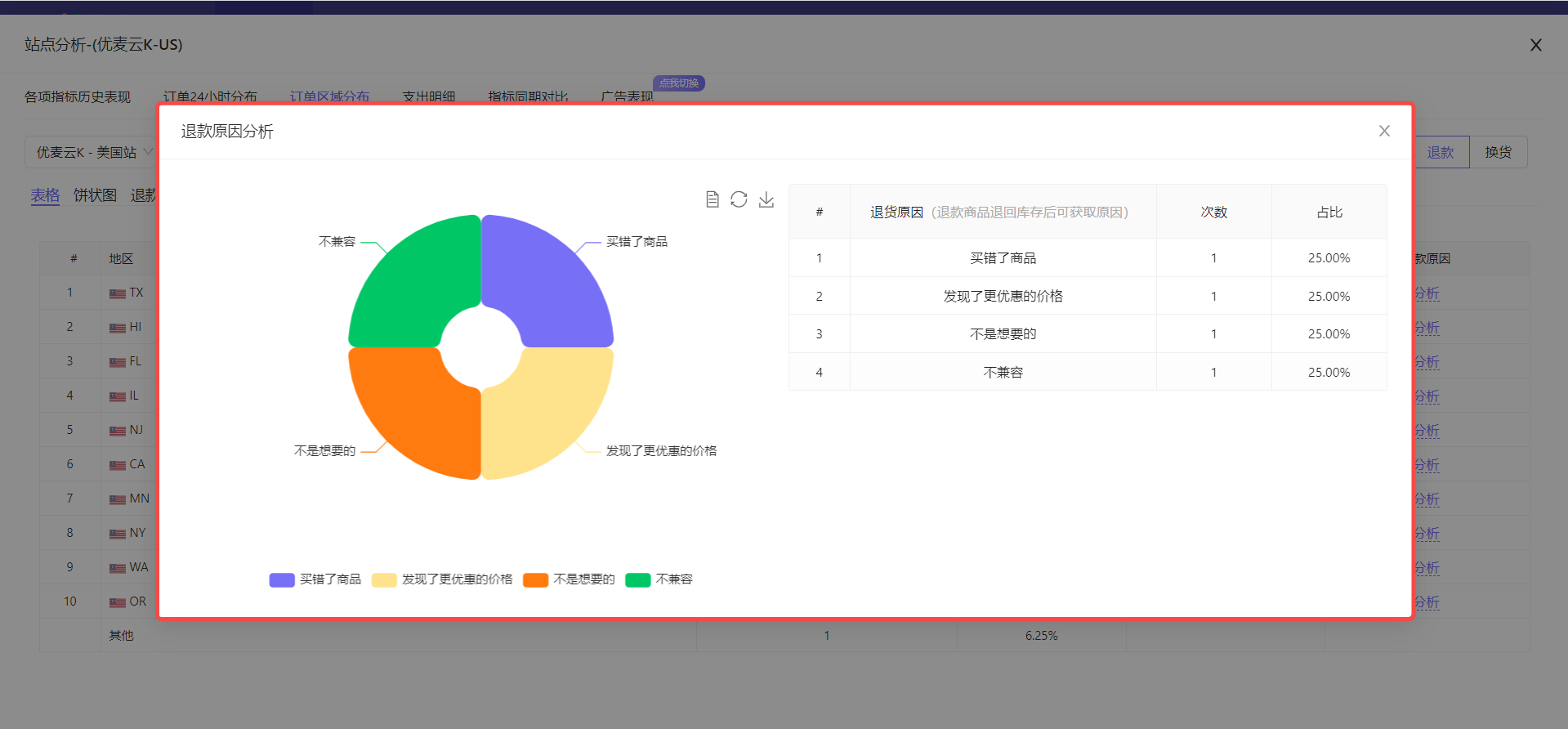 +
+
If there are many reasons for refunds, we can also click the slices below to display or hide the data separately.
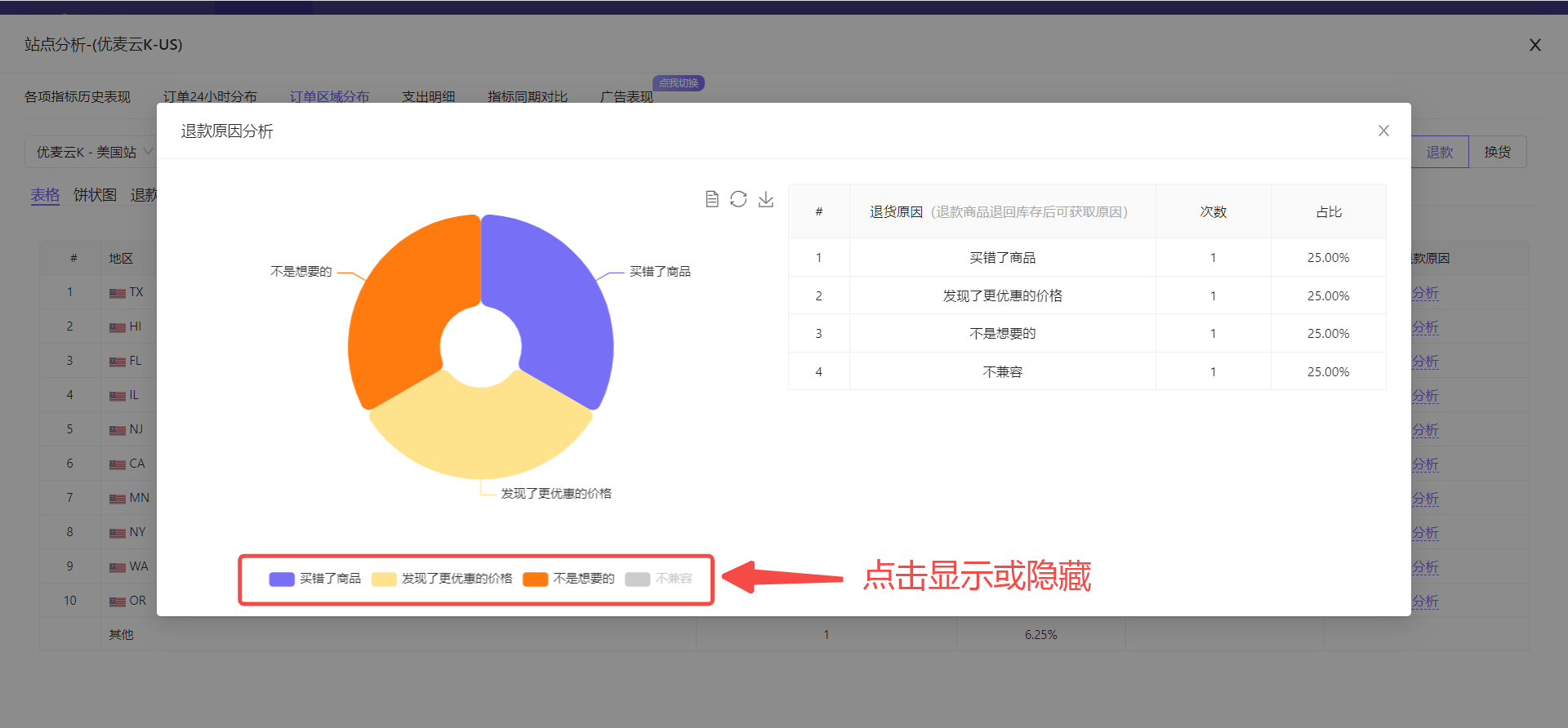 +
+
If there are many reasons for refunds, and there are many operations to display or hide separately, if you want to restore to the initial data display, you can click the restore button to restore with one click.
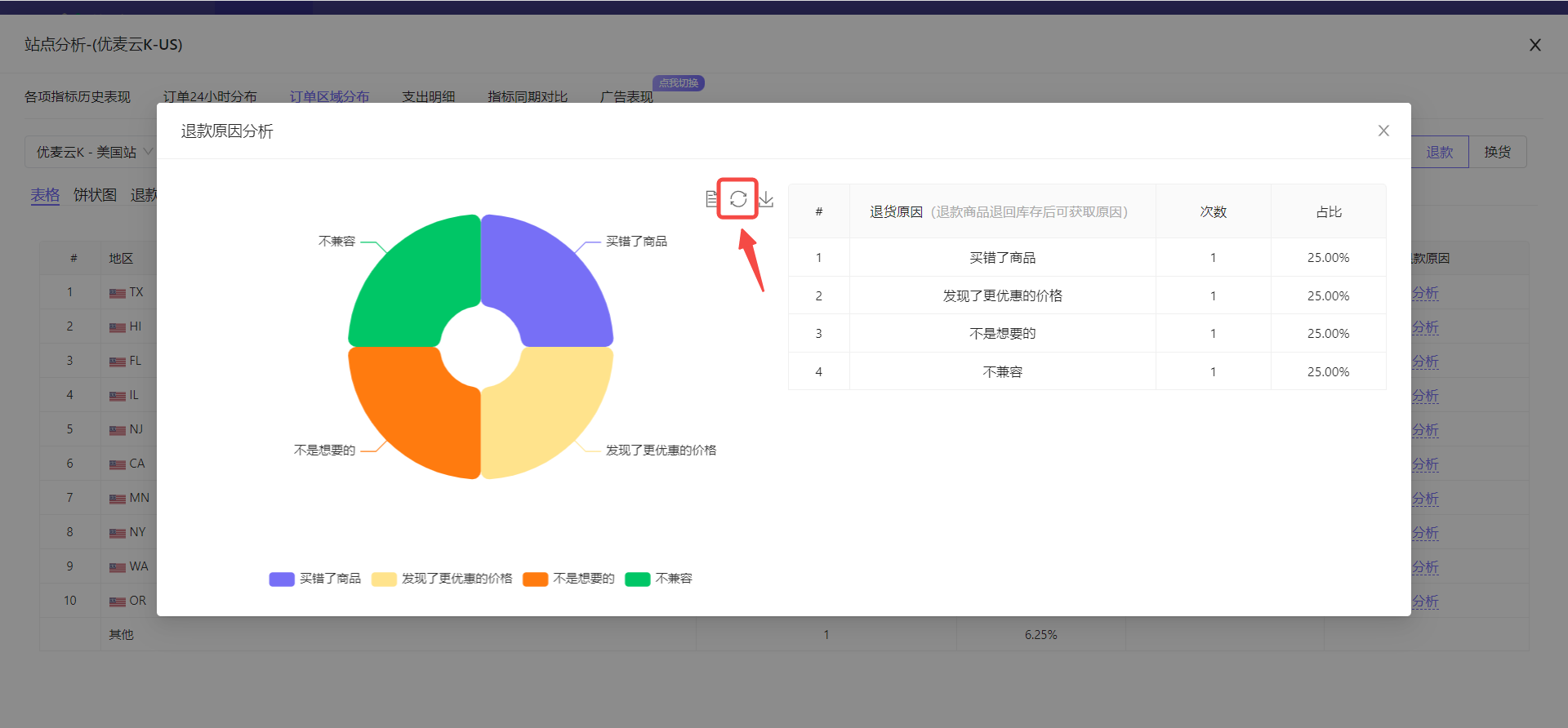 +
+
The current chart also supports export, and the export format is image, which is convenient for us to make reports.
Click the export button to export with one click.
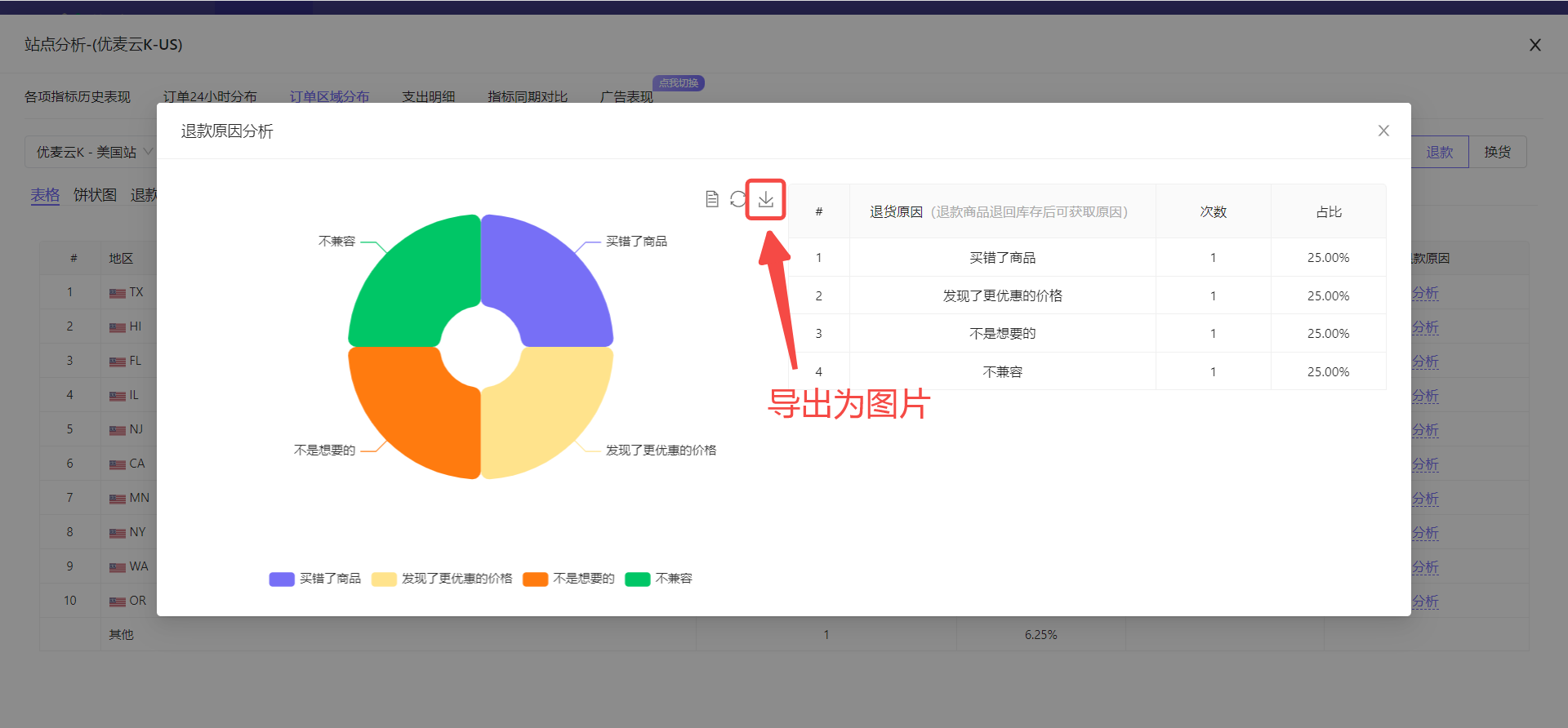 +
+
In addition to direct chart analysis, we can also switch to a pasteable and copyable table, copy the data out, archive it, or meet other copy and paste needs.
Click the chart button above to switch with one click.
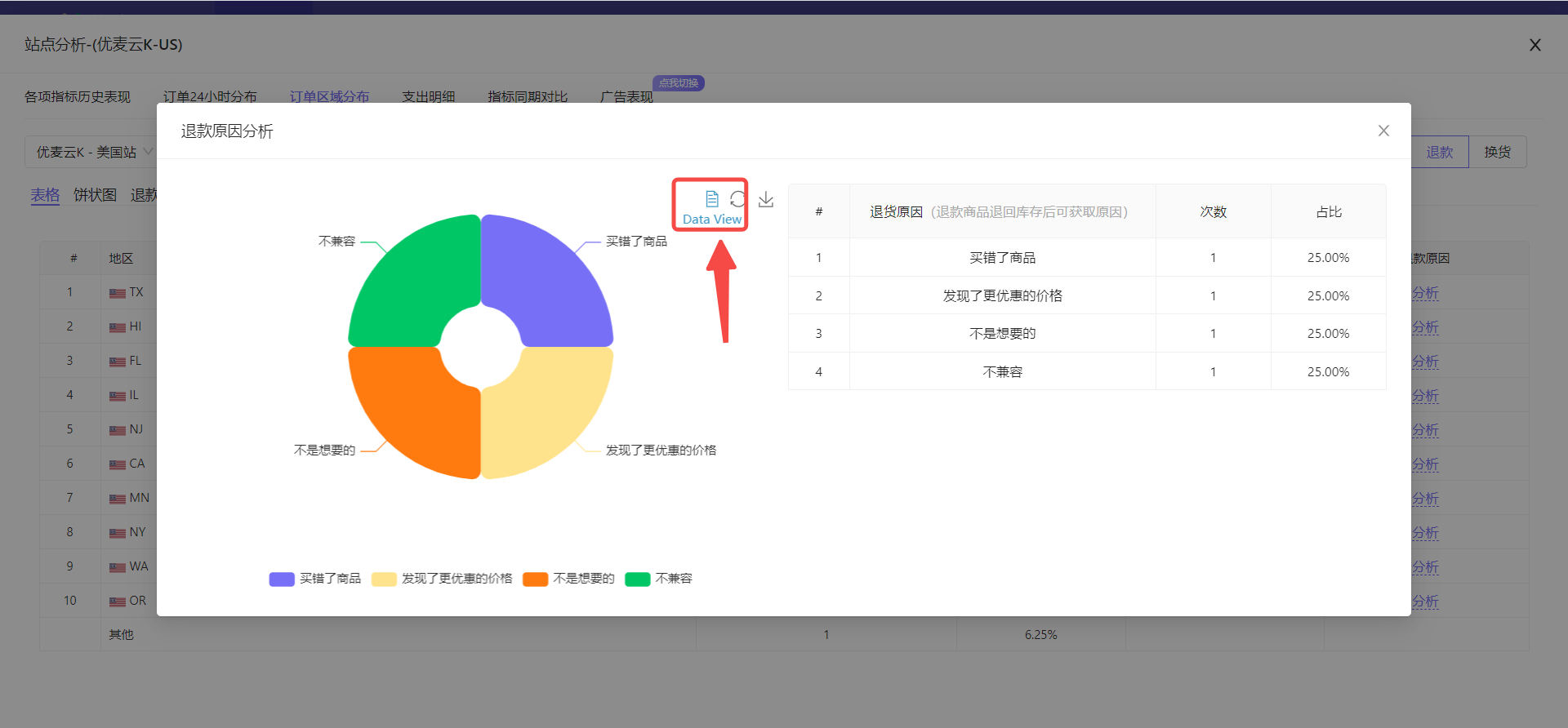 +
+
Directly copy and paste:
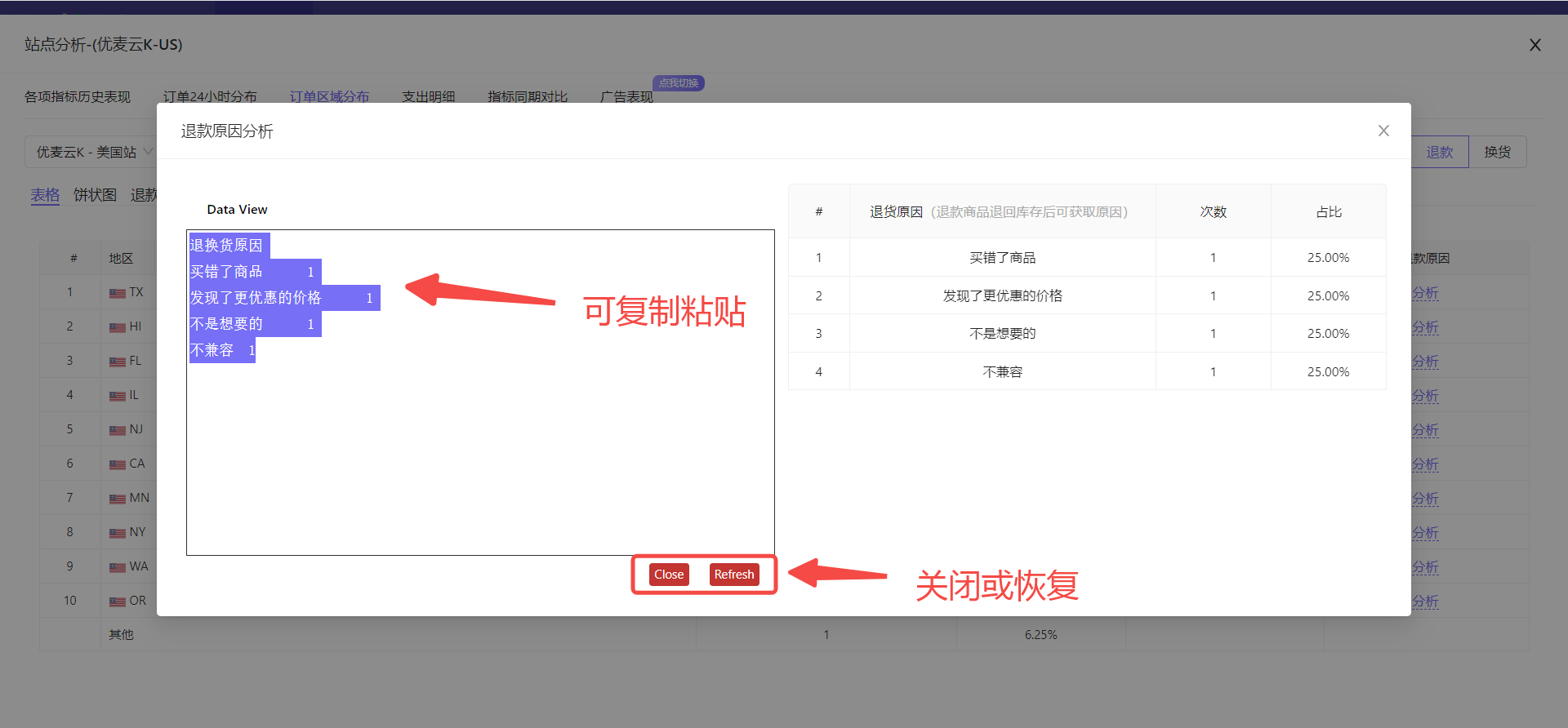 +
+
In addition to analyzing the reasons for returns and exchanges for the entire marketplace, we can also separately analyze the refund products and reasons for the top ten areas in terms of returns. (The operation of exchanges is consistent with it)
Enter the refund area distribution data page, and click the [View] button on the right side of the area to be analyzed to view the refund products in that area.
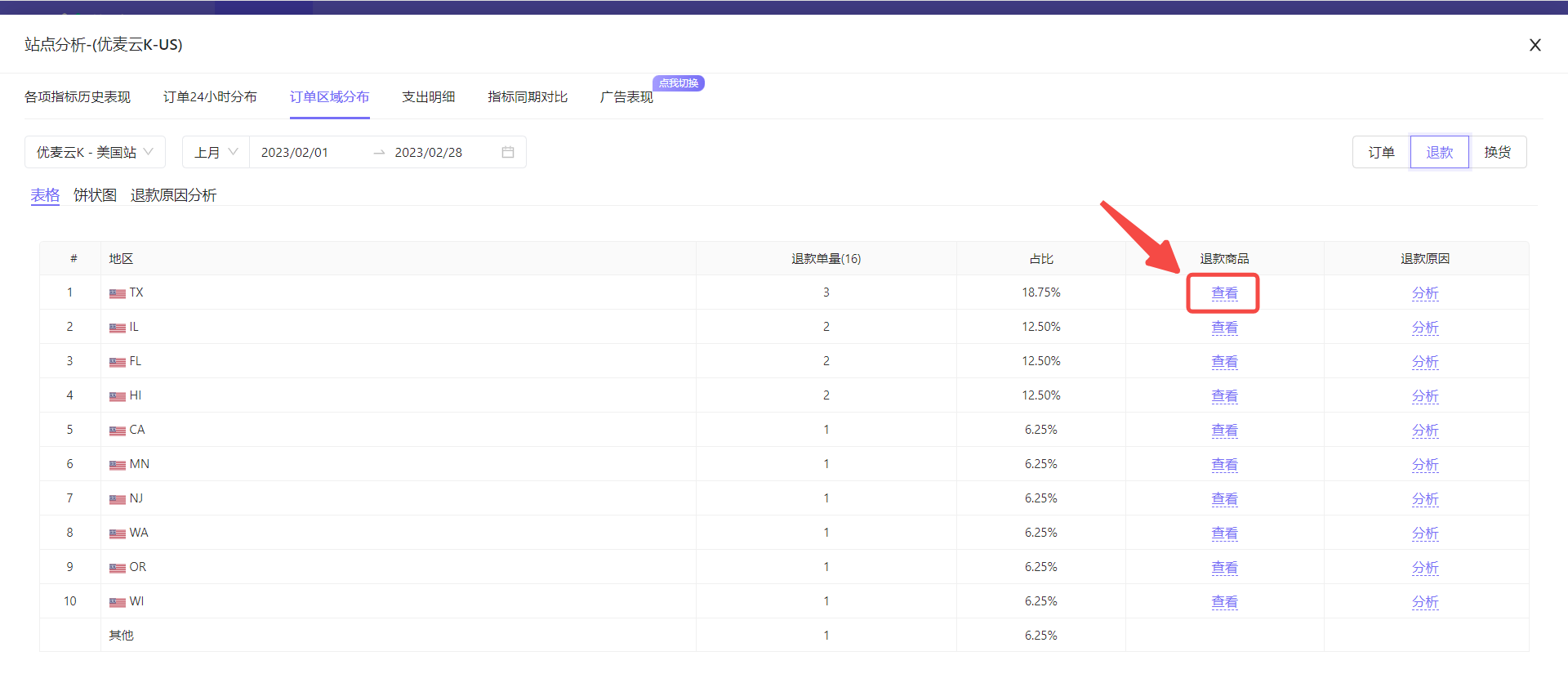 +
+
A list of refund products in the area:
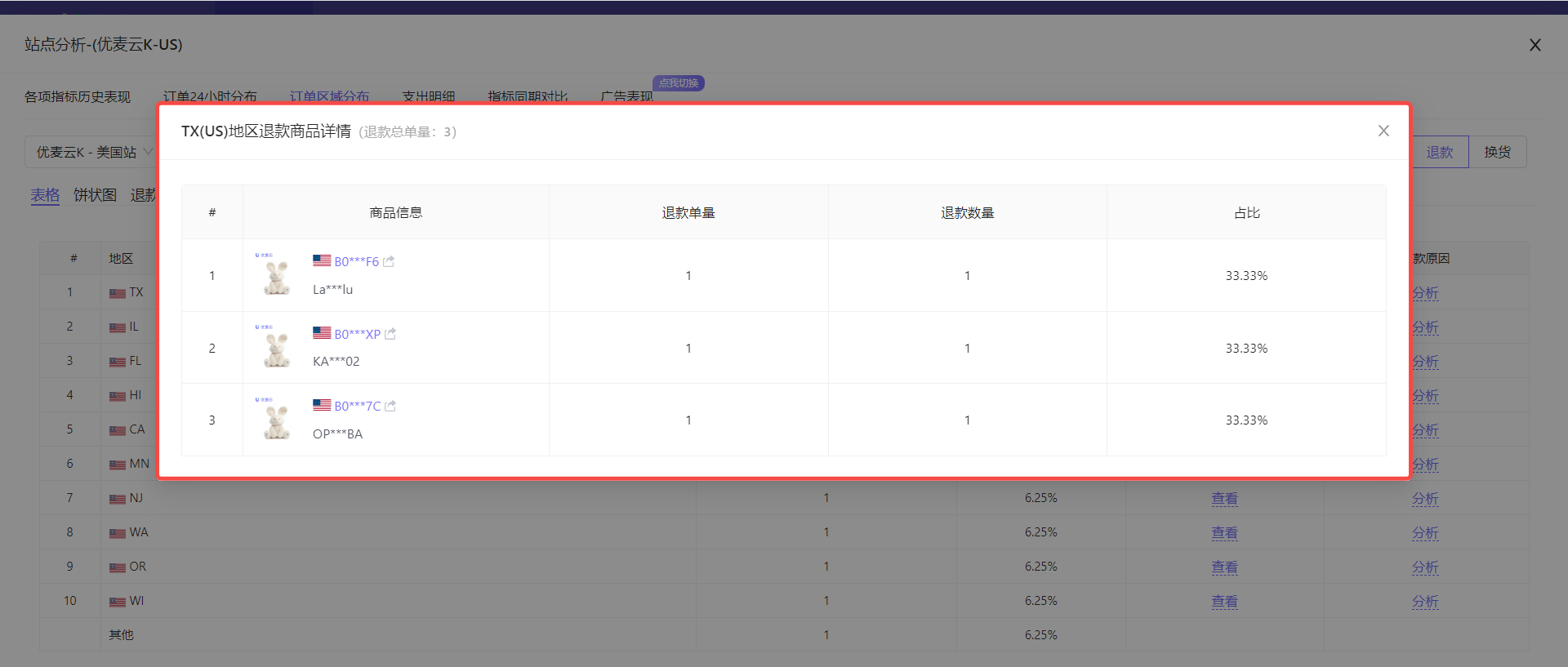 +
+
Click the [Analyze] button to enter the analysis of the refund reasons in the area.
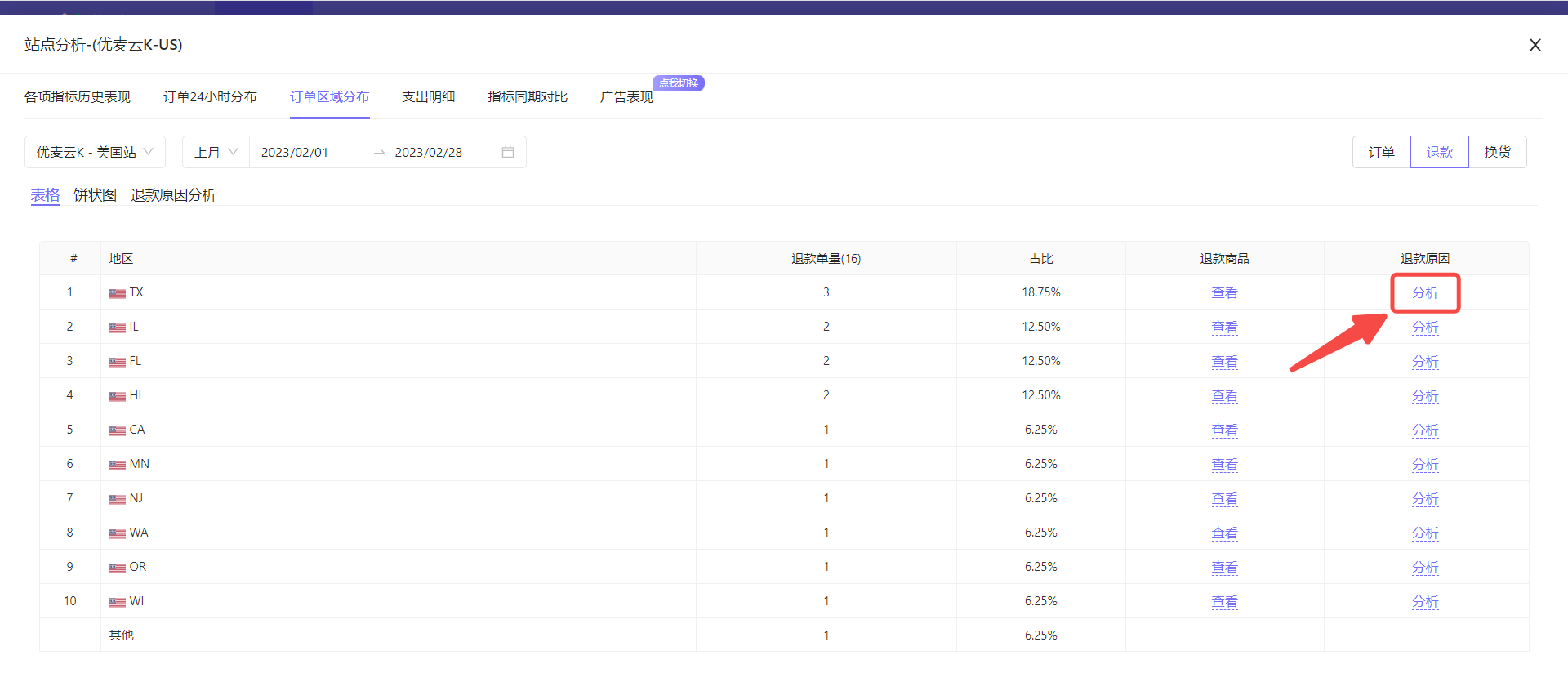 +
+
The analysis method is consistent with the refund and exchange reason analysis of the entire product.
 +
+
④ Expense Details
Expense details display various types of total expenses for the current marketplace, as well as the data proportion of each type, helping us review operating expenses.
We can quickly find out the main expense focus, whether the target expense meets the standard, whether there are any abnormalities in marketplace expenses, etc. by analyzing marketplace expense details.
 +
+
Taking the review of marketplace: SellerSpace K - US marketplace, marketplace expenses for last month as an example,
First, select the data time: Last Month.
Similarly, we can customize the data time range of expense details.
However, it should be noted that due to some pending orders, Amazon may return data as 0 within a certain period of time. At this time, we may adopt a budget. Therefore, if the selected time range is recent, Amazon FBA fees, commissions, and other fees may be 0 or distorted. Therefore, it is recommended to choose a time period with a larger span for analysis.
Click here to learn "SellerSpace Order Budget"
Click the time in the upper left corner and select the data time range: Last Month.
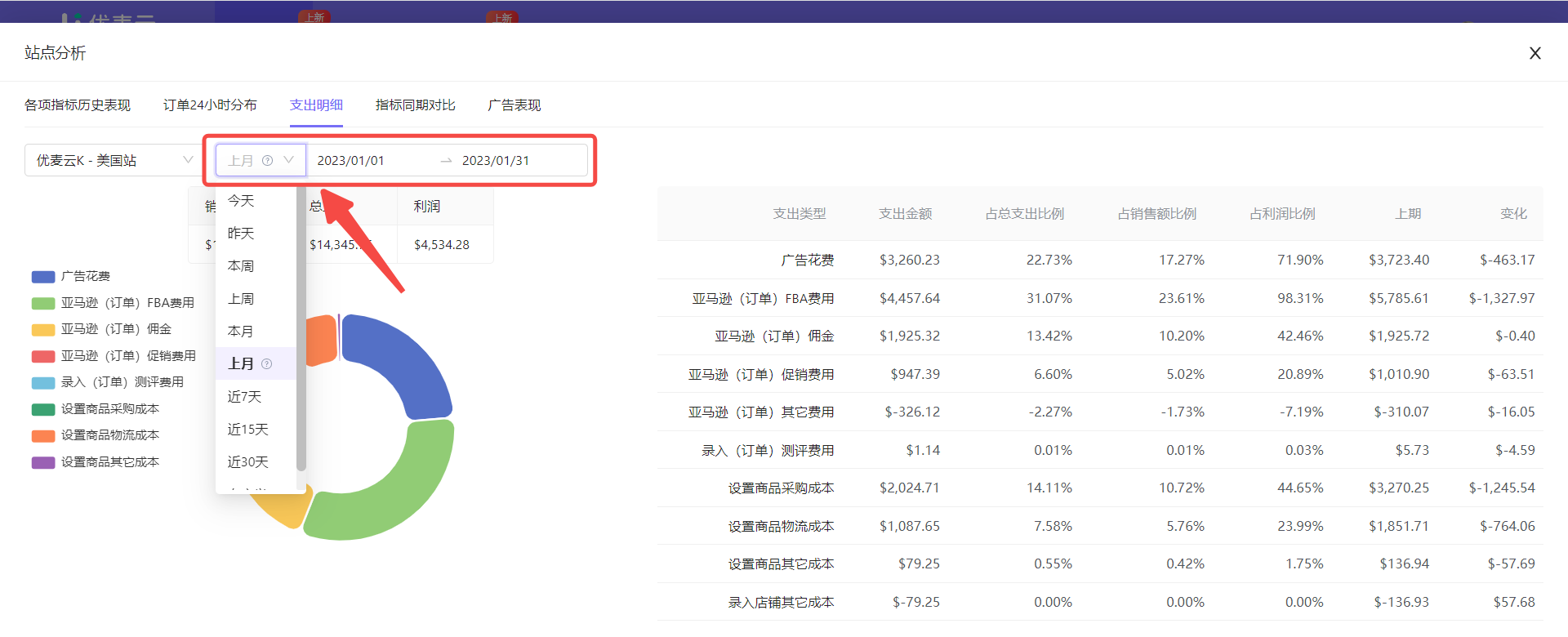 +
+
Then, select the marketplace: SellerSpace K - US Marketplace.
We can directly view the expense details of different marketplaces, so we need to set the marketplace to be analyzed.
Click the marketplace name in the upper left corner to directly switch the marketplace: SellerSpace K - US Marketplace.
 +
+
After the time and marketplace are set, the data below will be automatically switched. Including: Total Sales Revenue, Total Expenses, Total Profit, Expense Details, and Pie Chart of Each Expense Type.
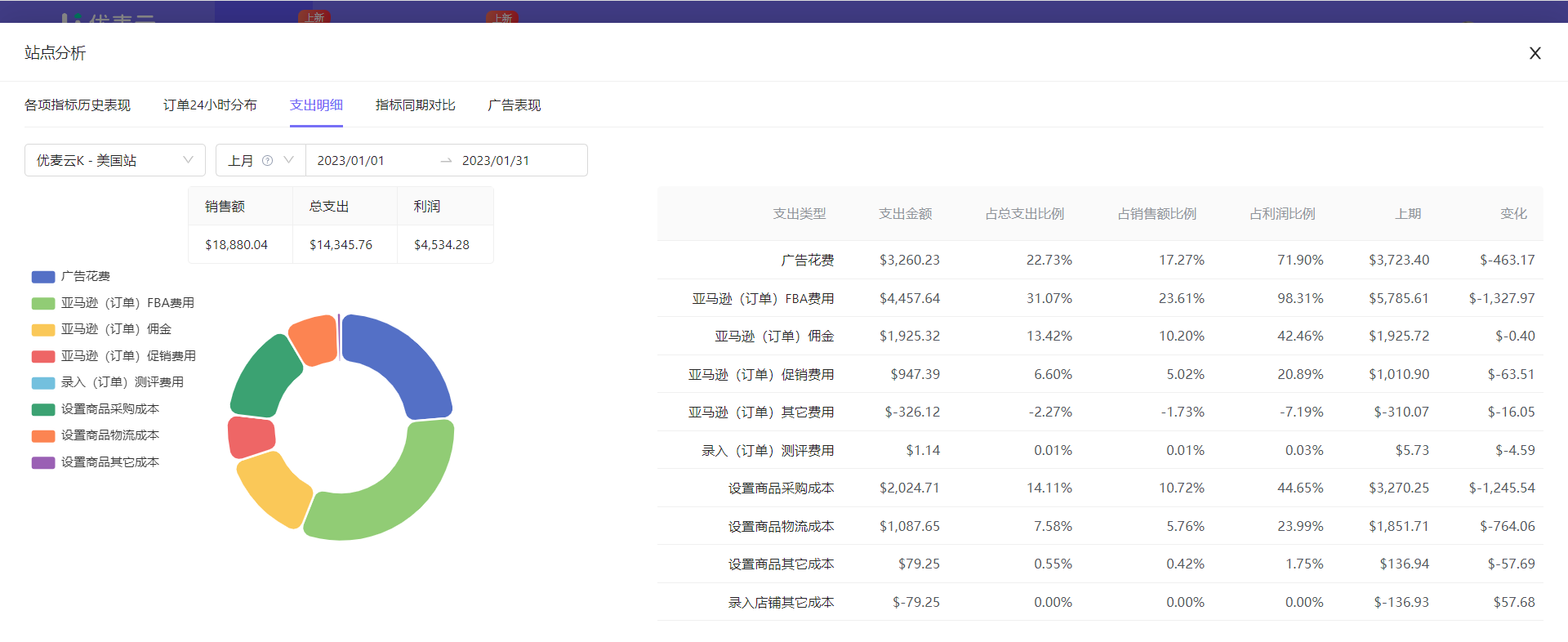 +
+
Among them, hover your mouse over each color block to also view the corresponding detailed data.
 +
+
At this time, we can directly analyze the expense details of SellerSpace K - US marketplace for last month.
For example:
From the above data, it can be seen that the overall profit of this marketplace is relatively low, and the proportion of advertising expenses is relatively high. We can speculate that there may be unreasonable aspects in the current advertising placement. Is it because of promoting new products, mainly through advertising to obtain traffic, or is there a problem with our advertising strategy that needs to be improved, etc.? Specific analysis needs to be made according to the specific situation.
⑤ Period-over-Period Comparison of Metrics
Period-over-period comparison of metrics can help us analyze the changes in various sales metrics of the marketplace, analyze whether the optimization operation is correct, and whether there are any abnormalities in daily operations, helping us quickly find loopholes and optimize in time.
 +
+
Taking the curve graph format to analyze the order changes of SellerSpace K - US marketplace last month as an example,
Click the metric selection bar in the upper right corner and select the metric to be analyzed [Order Quantity],
 +
+
After selecting the metric, we continue to select the marketplace, time, and data display format to be analyzed.
The above three operations are basically consistent with [Order 24-Hour Distribution].
We directly select SellerSpace K - US marketplace, Last Month, and curve graph.
 +
+
Through the above operations, we get the target data.
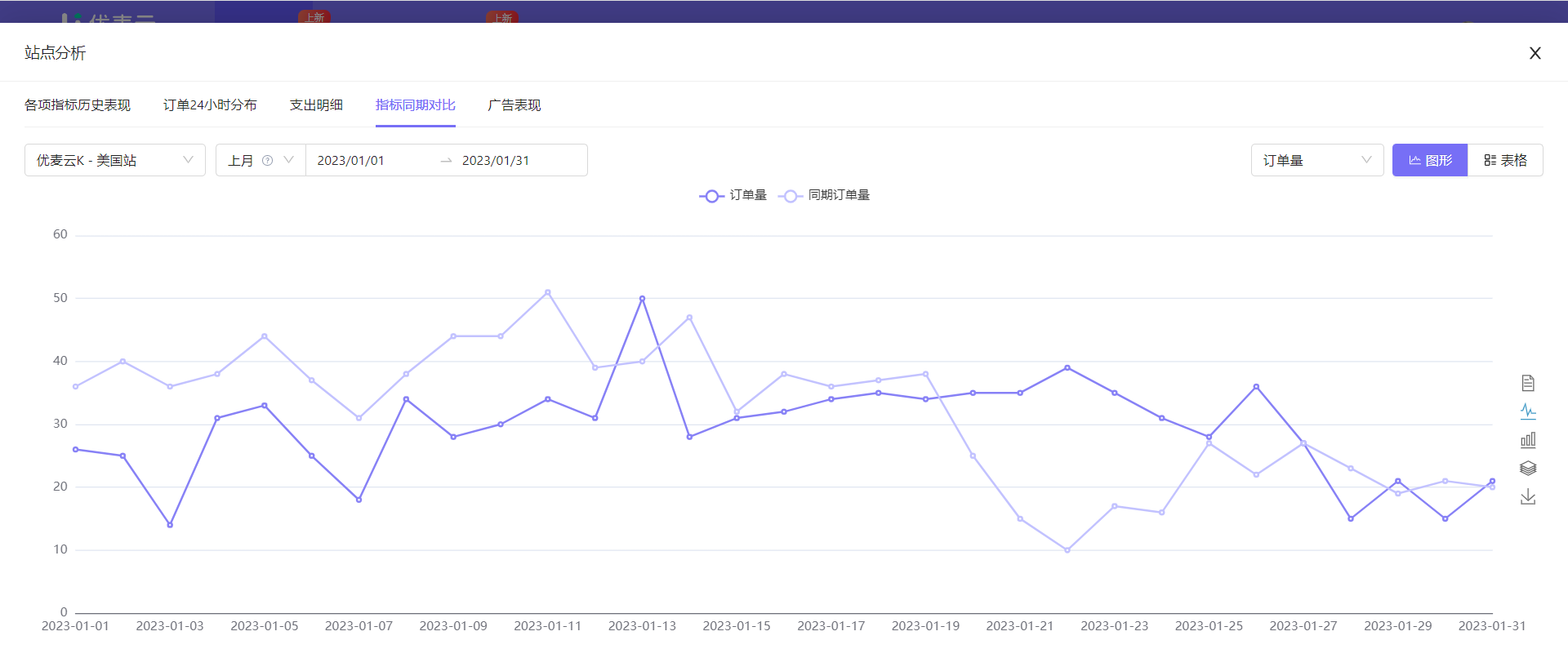 +
+
At this time, we can analyze through the curve chart.
For example, through the chart data, we found that from January 19, 2023 to January 27, 2023, only for this week, the order quantity of SellerSpace K - US marketplace has been exceeding the previous month. What could be the reason?
At this time, we can speculate that it may be that we have made some optimization adjustments that have had an effect, but have not been maintained; or we participated in a Lightning Deal, such as a 7-day Lightning Deal, which happened to be that week, allowing sales to rise, etc. We will make corresponding adjustments and optimizations based on different analysis results in the future.
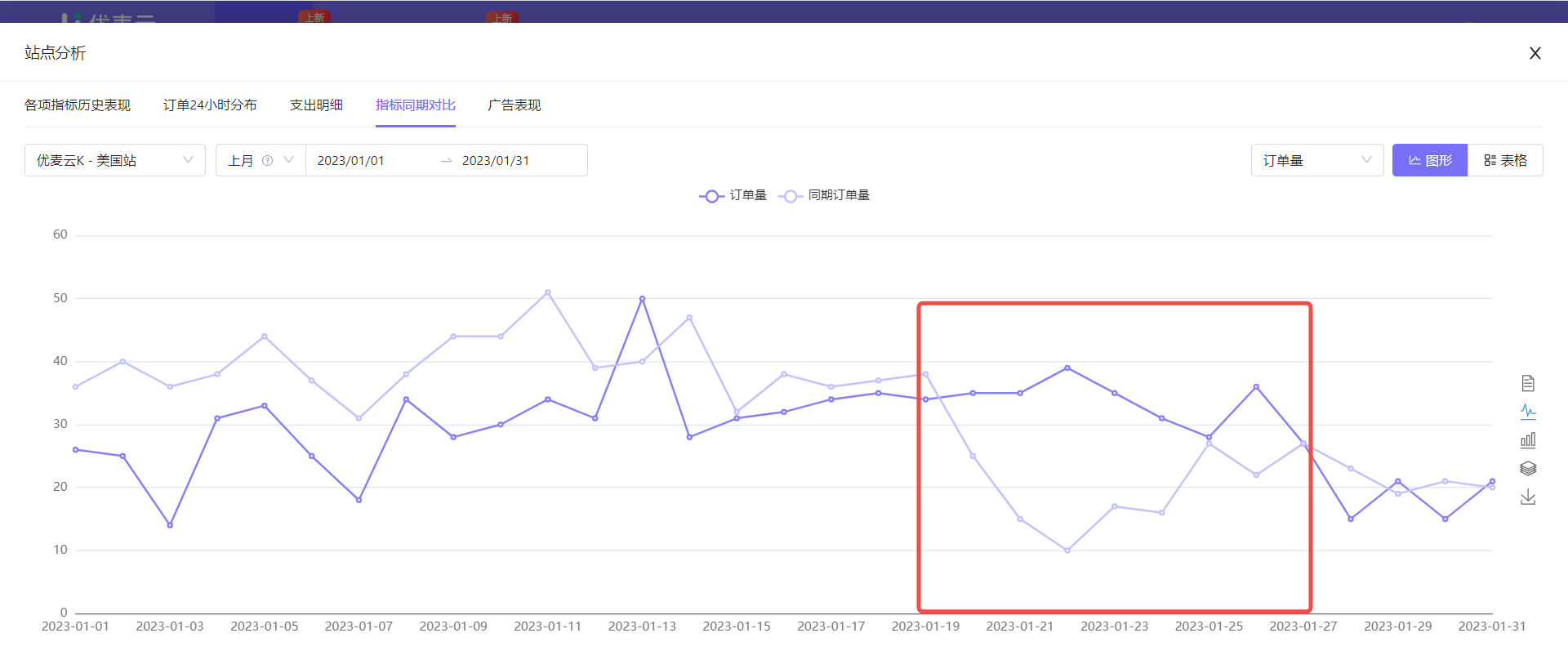 +
+
⑥ Advertising Performance
The advertising performance data of marketplace analysis displays the campaign performance data of all promoted products for the selected marketplace and time. We can directly view and analyze the advertising performance of the marketplace here, which is convenient and quick.
All analysis operation methods here are consistent with "Advertising Management -> Promoted Products".
Click here to learn "Promoted Products - Help Guide"
One point to add here: The advertising performance of promoted products does not include Sponsored Brands (SB) ads.
Why not include Sponsored Brands (SB) ads?
Because what is displayed here is promoted product advertising, which is product-dimension advertising performance, while brand advertising is brand-dimension, that is, marketplace-dimension advertising performance. The dimensions are different, and brand advertising data cannot be allocated to a single product, so it is not included.
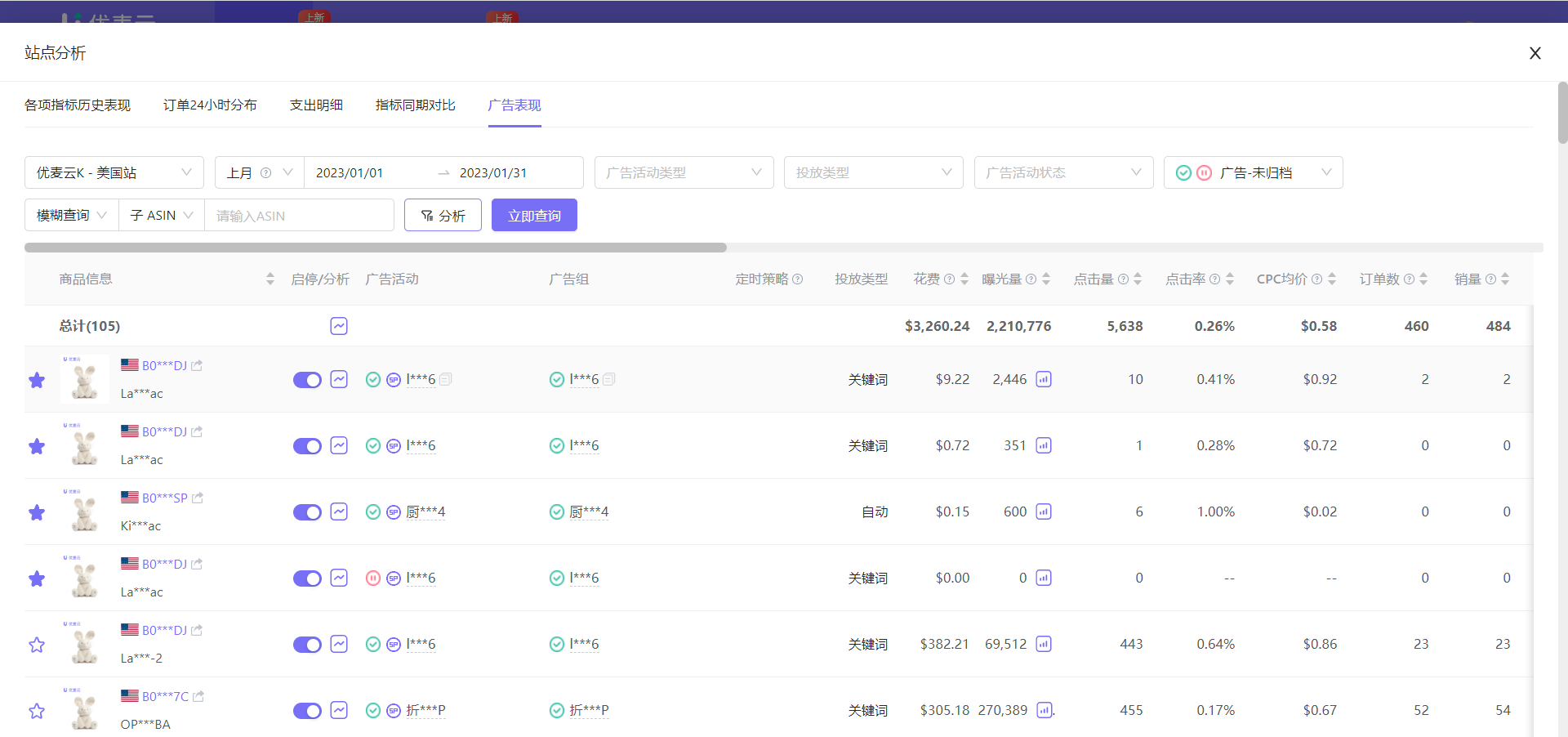 +
+
The above is the marketplace analysis operation method of the homepage dashboard.
In addition to the above marketplace analysis methods, we can also return to the homepage dashboard and click the [More] button in the upper right corner of the order marketplace distribution to jump to the [Marketplace Analysis] feature to deeply analyze the business performance of the marketplace.
 +
+
Click here to learn "How to use the Marketplace Analysis feature"
Marketplace Analysis:
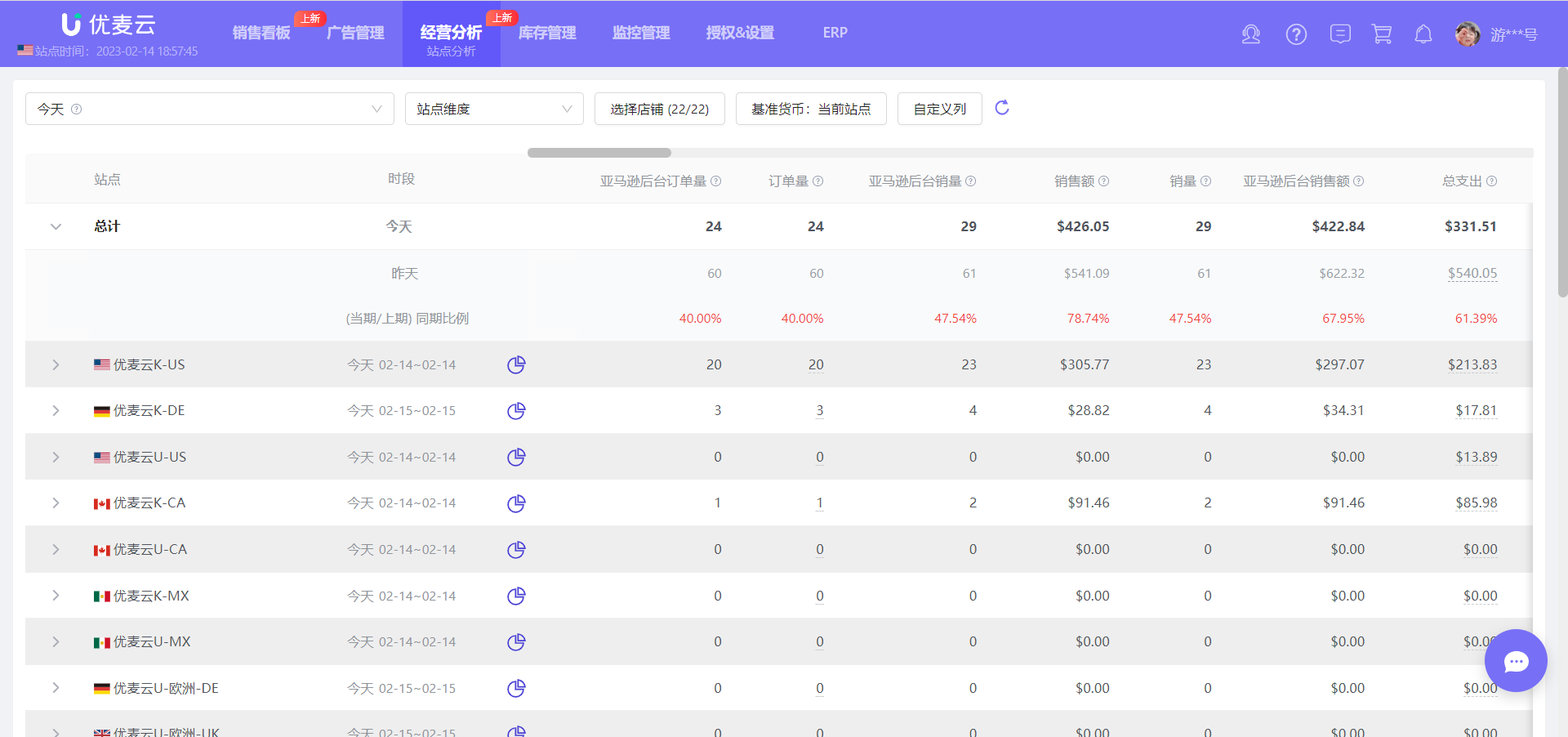 +
+
2.2 Order Product Distribution
Starting from the product dimension, it displays the core performance data of order products for the selected marketplace and time period.
Its analysis operation method is basically consistent with [Order Marketplace Distribution], but the analysis dimension is product dimension. The analysis dimension of [Order Marketplace Distribution] is marketplace dimension.
Next, we will mainly explain the slightly different operations due to different dimensions.
① Data Analysis Dimensions: Child ASIN, Parent ASIN, SKU.
We can view and analyze the data of order products from the dimensions of Child ASIN, Parent ASIN, or SKU. Starting from different dimensions, we can fully grasp the business situation of products.
Taking viewing today's units sold ranking of each Child ASIN as an example,
Click the switch button in the upper right corner to switch to [View by Child ASIN] with one click. The time defaults to today, no other operations are required.
 +
+
Click the metric sorting button next to the view dimension setting and switch to sort in descending order by [Units Sold].
 +
+
At this time, we can directly view the order situation of Child ASIN products today, sorted in descending order.
 +
+
Similarly, click the order quantity to jump to the [Order List] feature to view order details.
Hover your mouse over the total expense amount to view expense details.
 +
+
② Convenient Jump
After we analyze the product, if we want to further view other situations of the product, such as inventory situation, whether it is being hijacked, product cost, we can directly click jump here in the order product distribution, which is very convenient.
Click the jump button and select the corresponding data to directly jump to the corresponding feature.
 +
+
③ Product Analysis
Same as marketplace analysis of [Order Marketplace Distribution], [Order Product Distribution] also supports product analysis, and the dimensions in it are basically consistent with marketplace analysis.
We can directly complete the overall analysis of products on one page. By analyzing products, we can judge the progress of new product promotion, what life cycle old products are in, what kind of optimizations we can do for product promotion, etc.
Click the analysis button to enter the product analysis page.
 +
+
First, it should be explained that the data dimension of product analysis is based on the data analysis dimension we started to set.
For example, if we initially selected the Child ASIN dimension, then the data dimension in product analysis is the Child ASIN dimension, and so on.
The viewing dimension initially selected: Child ASIN dimension
 +
+
Product analysis dimension: Child ASIN dimension
 +
+
Enter the product analysis page,
The data analysis dimensions in product analysis are the same as marketplace analysis, including: Historical Performance of Various Metrics, Order 24-Hour Distribution, Expense Details, Period-over-Period Comparison of Metrics, and Advertising Performance.
The operation of each analysis dimension is basically consistent, refer to the previous marketplace analysis, and will not be repeated here.
 +
+
In addition, when using product analysis, pay attention to 2 points: Performance of Each SKU + Advertising Performance.
Performance of Each SKU
When the viewing dimension we select is: Child ASIN dimension or Parent ASIN dimension, the [Performance of Each SKU] dimension will appear in product analysis.
Why is this?
Because SKU is the smallest unit product of Amazon products. A Parent ASIN product (Parent ASIN) is composed of multiple Child ASIN products (Child ASIN); a Child ASIN (Child ASIN) can generate multiple SKU products (same product, different SKUs, such as hijacking operations).
Therefore, if we have the above product sales situation, we can analyze the data to the smallest dimension.
 +
+
Advertising Performance
The advertising performance of product analysis displays all the promoted advertising of the selected product.
What is the difference between it and marketplace analysis?
Marketplace analysis: Advertising performance of all promoted products in the entire marketplace;
Product analysis: Only view the advertising performance of all promoted products of the selected product.
 +
+
2.3 Order 24-Hour Distribution
Back to the homepage dashboard, in addition to [Order Marketplace Distribution] and [Order Product Distribution], we can also directly view the 24-hour hourly order distribution of the selected marketplace and time period on the homepage dashboard, helping us intuitively understand how many orders are placed at what time.
All operation methods of [Order 24-Hour Distribution] are consistent.
 +
+
Section 3. Advertising Performance
The advertising performance of the homepage dashboard is different from the advertising performance of [Order Marketplace Distribution] and [Order Product Distribution]. It displays the core advertising performance data of the selected marketplace and time period in the homepage dashboard, including: Advertising Orders, Spend, Sales Revenue, ASOAS, ACOS, etc. The data viewing operation is consistent with [Section 1: Real-time Sales].
 +
+
Click the [More] button in the upper right corner to jump to the [Business Analysis -> Marketplace Analysis] feature to further analyze advertising-related performance.
Click here to learn "Marketplace Analysis - Help Guide"
 +
+
Section 4. Profit & Expenses
Similar to [Section 3: Advertising Performance], it displays profit and expense-related data, helping us intuitively understand the marketplace's revenue situation.
All operation methods are consistent with [Section 3: Advertising Performance].
 +
+
Section 5. Top 10 Ads
The [Top 10 Ads] section displays the top 10 advertising data in terms of ACOS, Sales Revenue, Order Quantity, Impressions, Clicks, CTR, and CVR for advertising campaigns, ad groups, keywords, and non-keywords for the selected marketplace and time period.
Through the [Top 10 Ads] feature of the homepage dashboard, we can quickly discover abnormal advertising performance and optimize it in time to avoid missing optimization opportunities and causing unnecessary waste.
 +
+
When we find that there is an abnormal situation in advertising and need to do further analysis and confirmation, we can click the small eye icon next to the advertising campaign to jump to [Advertising Management] to view detailed advertising performance.
 +
+
Click the historical performance icon on the right to view the historical performance of the ad. Note: The chart operation method of historical performance is basically consistent with other charts mentioned above.
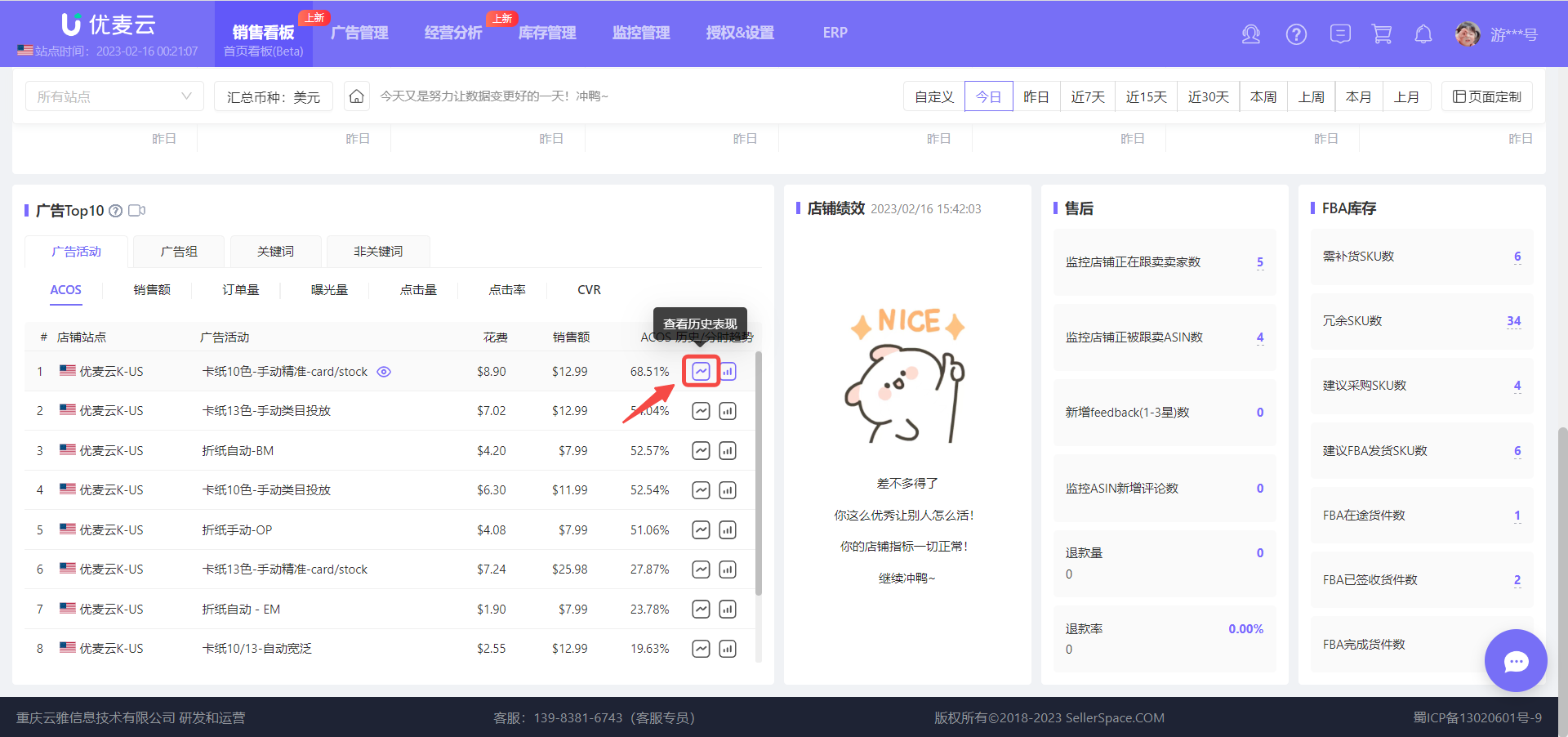 +
+
Historical performance:
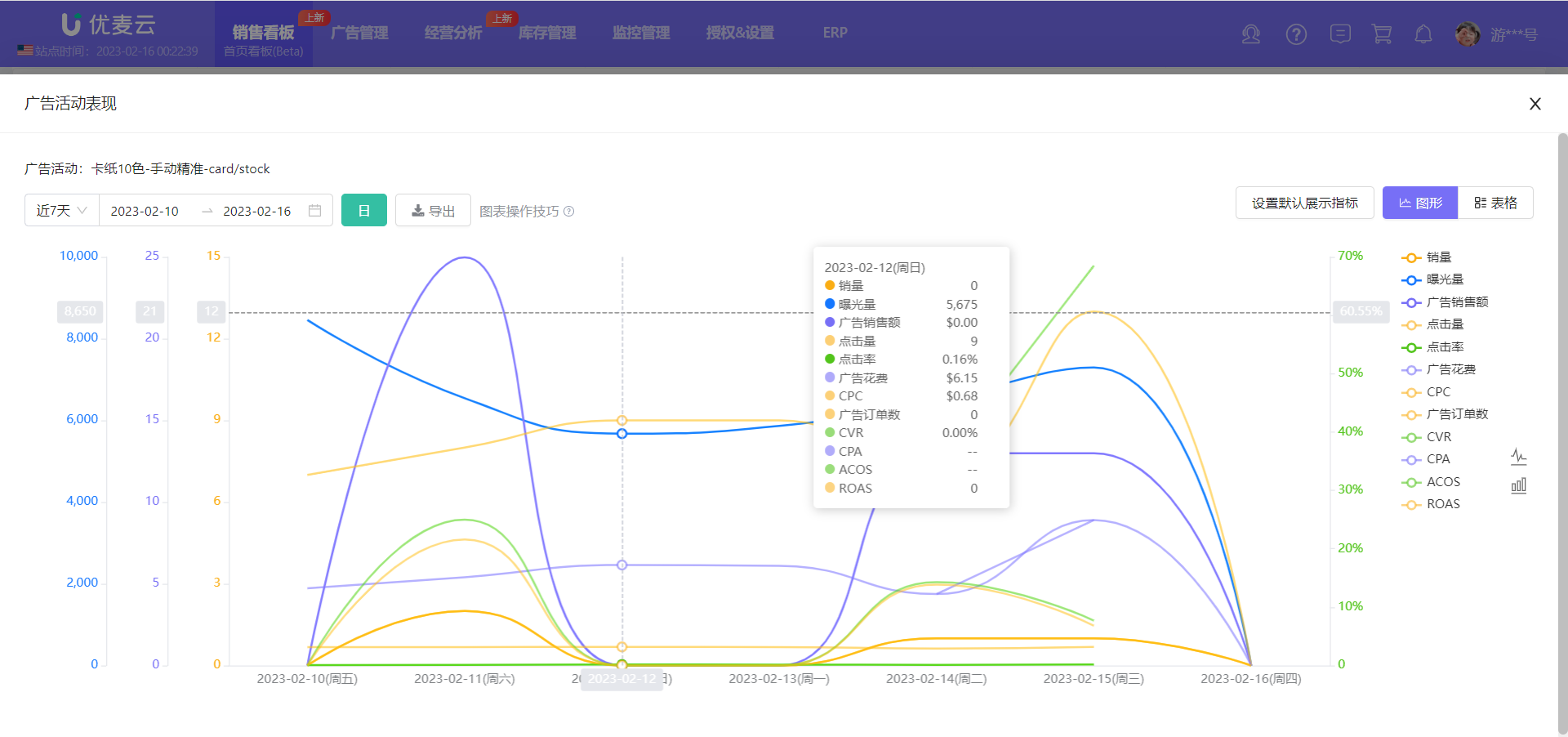 +
+
You can also click the hourly trend button to analyze the hourly advertising data changes in the last 15 days.
Click here to learn "How to use hourly trend data"
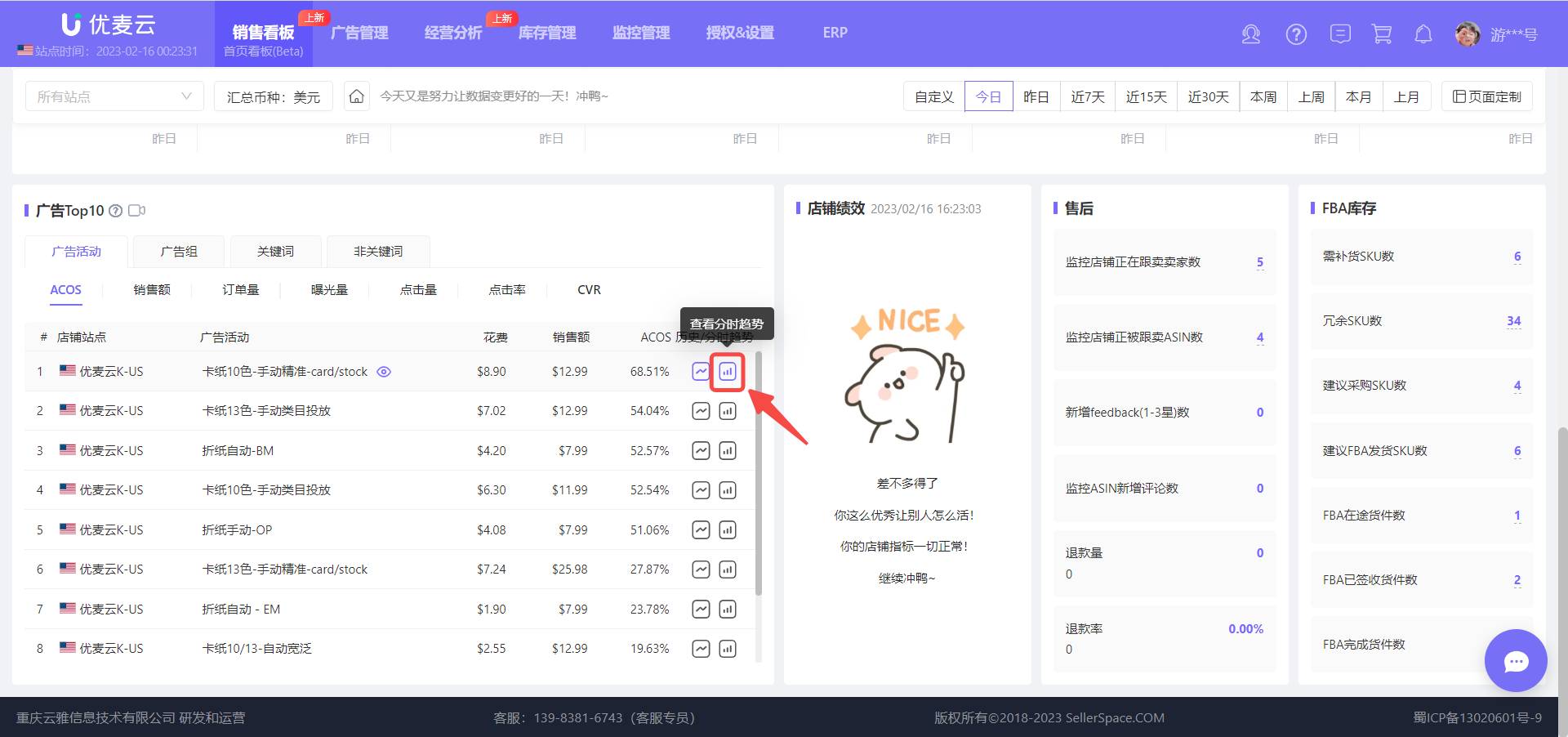 +
+
Hourly trend data:
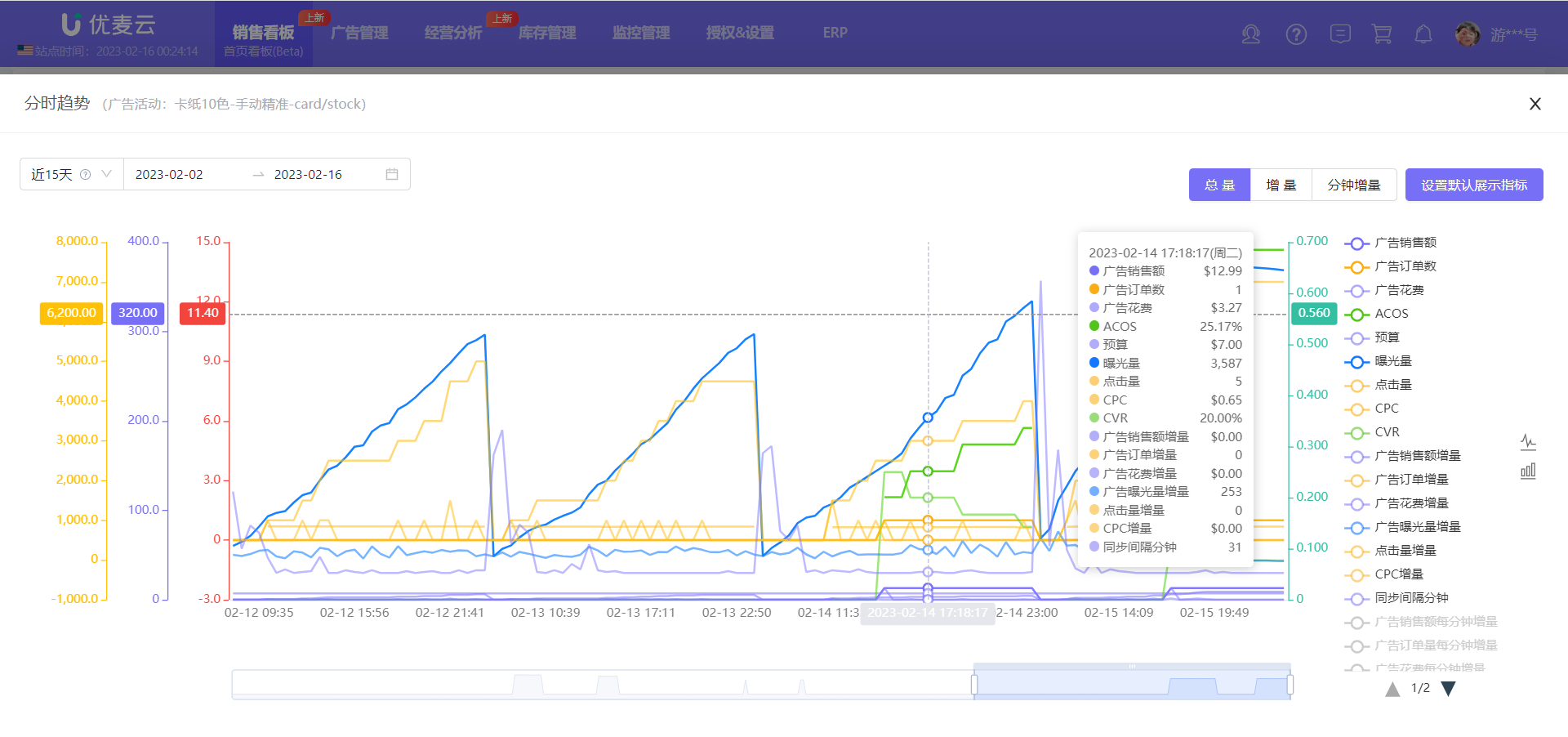 +
+
Section 6. Store Performance
The Store Performance section displays the performance situation of the currently monitored stores.
If there is negative performance, such as negative feedback, violations, etc., it will be displayed here. We can directly see how many negative performance items there are here.
If we bind WeChat, once negative performance occurs, in addition to being displayed on the homepage dashboard, the mobile WeChat will also receive real-time notifications, so that we can handle it in time.
We can bind WeChat in the profile center. Click here to learn "How to bind WeChat"
 +
+
Section 7. Customer Service
The Customer Service section mainly displays hijacking, negative feedback, new comments on monitored products, and refund data.
Through the Customer Service section, we can quickly understand some customer service metrics that need to be paid attention to in the store at present, handle them in time, and save operation time.
 +
+
Click the number of hijackers and the number of hijacked ASINs to directly jump to the [Hijacking Monitor] feature to view the corresponding details.
Click here to learn "Hijacking Monitor - Help Guide"
 +
+
Section 8. FBA Inventory
The FBA Inventory section displays the FBA inventory situation of currently selling products, including restock needed, redundancy, and the in-transit and signed-in status of shipments.
Through the FBA Inventory section, we can quickly understand the current inventory of products on sale, which ones need to be handled in time, such as restocking or clearing inventory, and the delivery status of shipments, whether there are any abnormalities that need to be followed up, etc.
 +
+
Click the number on the right side of the corresponding metric to jump to view the corresponding details.
 +
+
It should be noted here that the FBA shipment status displayed in the FBA Inventory section refers to the shipment status of shipments delivered in SellerSpace, not the FBA shipment status in the Amazon backend.
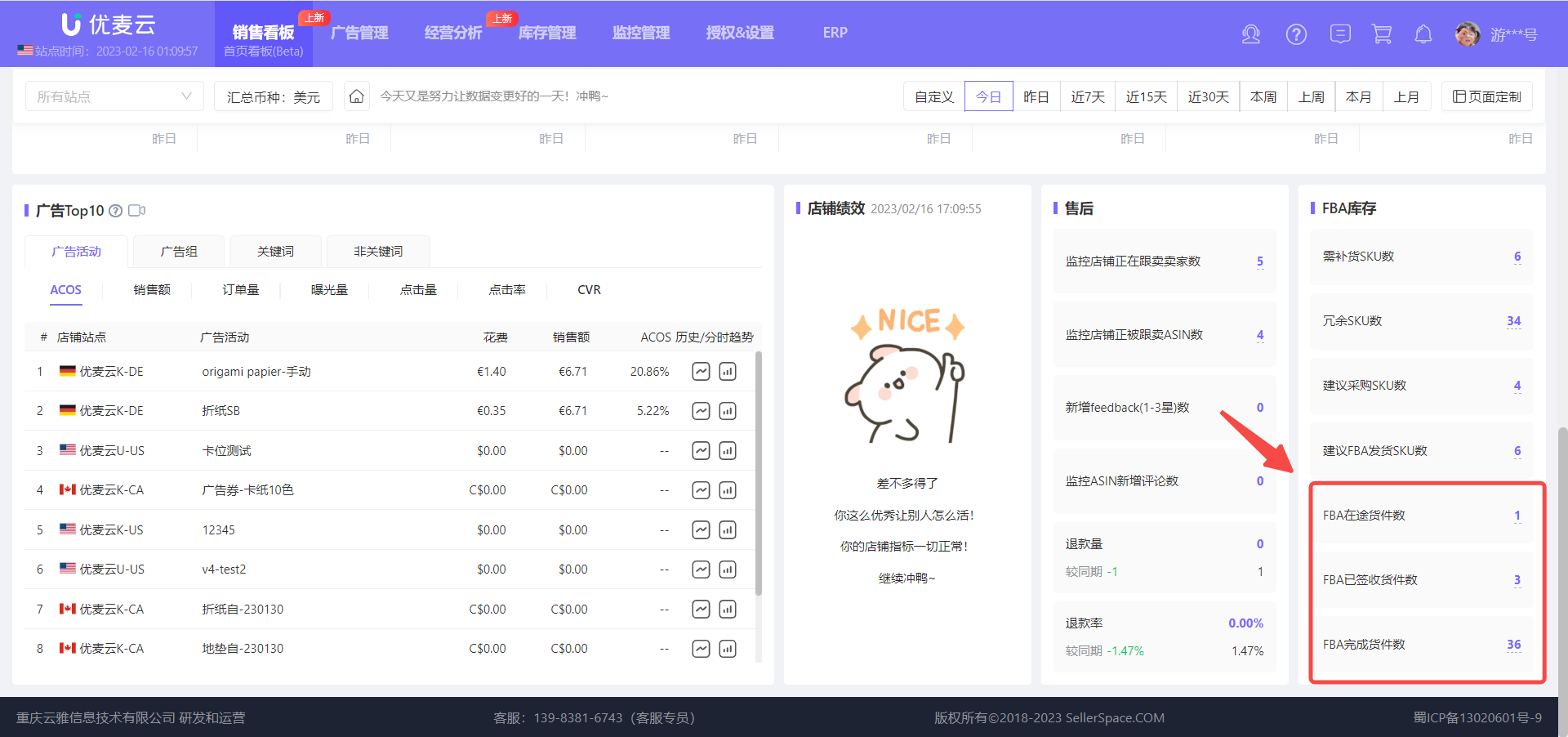 +
+





